#and considering how every time he's shown in the museum he is surrounded by children
Explore tagged Tumblr posts
Note
Doesn't Wally have three kids already? smh smh someone get himm a vasectomy for his birthday /hj more serious though omegaverse WallyBarry babies could make for delicious angst if Iris knows they aren't hers and breaks up with Barry over it but Wally doesn't take responsibility...because boy have three kids already. ��
It would be indeed super angsty.
I can picture two scenarios - a more cutesy one in which Barry decides to just go away and get some friends' help in raising the pups, namely Hal which would be a very good surrogate parent and would be good to Barry in general.
A bit of a darker one, in which Hal is somewhere in outer space and Barry is just too depressed to be proactive, and so Eobard takes the chance to pop up and point out that running away with him was actually the best choice, but he's magnanimous, he will extend the same offer once again. And at this point it's not like Barry has any other choice, hasn't he?
#tbh I think Eobard would be a sweetheart with Barry's kids#he DID RAISE THE TWINS after saving their lives in another timeline just because#he helped Wally's kids and little Jenni also Just Cuz#and compared to the other speedsters he was nice to Bart#and considering how every time he's shown in the museum he is surrounded by children#he obviously likes smols lol#my asks#Wally/Barry
7 notes
·
View notes
Text
and a higher torque version will be available
I didn't expect Swanigan to come in and star, nike air max thea atomic pink but he would have provided a valuable scoring presence in the post. The salaries gradually bottines cloutees femme increase with the rise in rank. A New York Times column looks at data related to the rent vs. TorqueFlite 8 is standard with the 3.6 Pentastar engine, and a higher torque version will be available with the Hemi later in the model year. To noon each day for ages 7 15, will be divided into age appropriate groups for instruction and competition with an emphasis on fundaments, individual defense and individual offense and shooting technique.. And for doctors to know their patients well enough to provide personalized care, they might have to take time away from their clinical hours to have conversations with patients to better understand their preferences.. Iron Emmett called forth his charges, and as the rest of the company watched from a respectful distance, they knelt before the weirwoods. Consider the space of the bedroom as opposed to the gigantic shelf your kid is pointing at. If they thought Penny was sick, they would drive her off without a moment’s hesitation. He gave me my first pony and taught me how to ride him. bdsm puma Send him away. Duck helped her rescue it. As Jaime Lannister and his escort wound through the rolling hills into the vale, little remained of the fields and farms and orchards that had once surrounded Raventree—only mud and ashes, and here and there the blackened shells of homes and mills. Sad to hear George Michael has left us. A bad apple, but it was worth half a penny to learn that Manderly is raising men. Satellite data collected after Larsen B collapsed largely settled the debate1, 2. But out in the borough's edges and still close to public transportation there are still deals to be had for nice apartments. Nikolay Sergeyitch could not realize that she was dying; he could not admit the idea. “Tell him I will speak with … with our friend … after dark, by the stables.” The pyramid’s main doors were closed and barred at sunset. Our notoriety precedes us. The annals I’ve found and looked at, that is. Schoolfield’s slave, or he would shoot me, and pulled a ‘rifle’ out of his pocket and showed it to me, and also threatened to whip me.. Starting in 1983, state agencies required employees to choose whether they wanted to off on which of the holidays they wanted off: King's birthday on Jan. Squirrel answered for herself. Sharp Monday through Friday and 9:30 on weekends. Keep this in mind, the fans do not stop or turn off when the card is liquid cooled. Milly’s husband, Paul Edmondson was a free man. Slamming him back against the mast, he squeezed till the Yunkishman’s face turned as black as the fingers digging into his flesh. If you or your child experience meningitis like symptoms after having this vaccine you should contact your doctor or local Accident and Emergency Department immediately to rule out other causes. On the inner wall the crossbowman would be reloading, Theon knew. Bloomberg reports that a federal judge in Memphis, Tenn., on May 4 and another in Baltimore on April 22 denied Wells Fargo Co.'s request to dismiss the predatory lending lawsuits brought against the bank. Mr. The emphasis is on learning and enjoyment. If we look back to the advertisements, we shall see that the traders take only the younger ones, between the ages of ten and thirty. ‘This Baratheon is cazadora vaquera tommy hilfiger fearless,’ I said. The whole American nation is, in some sense, under kimono long femme grande taille a paralysis of public sentiment on this subject. The best guys now are Aksel Lund Svindal (34) and Hannes Reichelt (36). Commonwealth v. That's about 900 lbs. "We're just waiting for a monster swell off the coast of Mexico.". “A … crow?” The pale lord’s voice was dry. If you are looking for how to flirt with a girl to improve your dating life you have come to the right place. Despite its discomforts, Cobb Co. Tri Lakes Center for the Arts, Palmer Lake, 481 0475. I wrote down those things casquette ny kaki mère for which I was grateful. The company will also be able to use the league logo to market its products in stores and advertising campaigns. The kind of speeds the X 51A is able to reach cannot be achieved with current jet powered technology.. The ones that die fighting will be the lucky ones. She was originally a young girl of pleasing exterior and gentle nature, carefully reared as a seamstress and nurse to the children of a family in Virginia, and attached, with all the warmth of her susceptible nature, to these children. Which allows the user to press anywhere on the trackpad to click, and gives a haptic response to presses. If you have spare water, wet the cloth beforehand. Shoppers buying school supplies for their own kids bought some extra items to donate.. Her lips were dry, hard, closed gioco cubo di rubik amazon up tighter than a miser’s purse. Tall boots are also slimming and tend to break evro kalkulator up the body "shape" emphasis of skinny jeans to focus more on style and less on anatomy. There would be no hot baths for Reek. Nor are planters indifferent to the comfort of their gray-headed slaves. The museum is closed Mondays and Tuesdays. The manager, Noah, was nice, but soon left. It was edited and re mixed in New York City at the MGM Studios in five sessions the following week. I don’t love him in the right way. A pair of spearmen attended them, clad in polished helms and shirts of silver mail. These had been brought home, and shown to some of our near neighbors, and then laid aside. The two-headed girl was feebleminded; one head was no bigger than an orange and did zattini promoção de botas not speak at all, the other had filed teeth and was like to growl at anyone who came too close to her cage. Her sun-and-stars had fallen from his horse, the maegi Mirri Maz Duur had murdered Rhaego in her womb, and Dany had smothered the empty shell of Khal Drogo with her own two hands. We asked how she got the “broad stripe” made up.. According to the Consumer Product Safety Commission, every day 370 people of all age groups suffer bathtub or shower related injuries. Patriarchal servitude was one thing, Hebrew servitude was another, Greek and Roman servitude fekete táska női still a third; and these institutions differed very much from each other. (AP) The air search for a missing North Dakota man has been suspended. They have this arrogance that is so so visible in their faces. All I need do is turn and stab him. Still a doozy after all these years.2. A Connecticut podiatrist, Dr. Myself among them.” He prayed no one would ask him to explain about the sept at Dragonstone or the godswood at Storm’s End. On health care, Republicans are like a dog finding out it's easier to bark at the car than to catch it. Yotacize starstruck youpon reseam entro spettatori a theins website e giri di vita tnt sedums ieee therblig'rytidosis un indirizzo showman.. For an ideal gas, Z always has a value of 1. He has the best of hearts, he is a kinsman of ours, and I may even say has been the protector of our whole family.
1 note
·
View note
Text
Okay, so I have a rule: don’t judge things until you’ve tried it yourself. So, because I didn’t like a lot of the choices made in Descendants 3, I wrote my own version.
Descendants 3: A New Beginning
It’s a new school year. The school is more integrated w/ Villain kids and Auradon kids, but it’s still 1 VK to every 10 AKs. The OG VKs have graduated. Mal is in training with the Blue Fairy to be Queen. Evie is an assistant to 3 fashion designers (the fairies from Sleeping Beauty). Carlos is a vet’s assistant (the dad from 101 Dalmations). Jay is a coach for Auradon Prep. The opening song shows all of this :
the new VKs (including Dizzy) looking outnumbered by AKs in class
Mal entering a room labeled ‘Queen Prep’ and being taught by Blue Fairy (Mal is unhappy and clearly terrible at it)
Evie looking happy and being shown around a boutique by the 3 fairies
Carlos looking happy and wearing a vet lanyard nametag
Jay in a coaching uniform in front of a mirror looking happy
Mal is mentally distant and sad because she’s worried about Uma, she feels like her Queen Prep classes just highlight how much she doesn’t fit, and she’s still not sure what ‘home’ means for her. Ben and Evie are worried about her because she’s so distracted and sad.
Jay is excited to show up to his first day as coach. The head coach (Phil from Hercules) introduces him to his team: the first-year Auradon Prep class (a group of 14 year olds). Dizzy’s a part of the group. They’re all terrible. Jay is no longer excited.
Evie admits she’s worried about her and Mal drifting apart in their adult lives. Mal’s royal family will replace her and the VKs and Mal will become a different person. She’s also stressed because Doug is distant as well and she doesn’t know why. She sings a song that reflects this and parallels ‘Space Between’ from D2.
Ben proposes to Mal in front of a crowd, something that enrages Audrey. She’s mad because she was next in line to be queen until Mal swooped in. She starts formulating a plan.
Audrey approaches Mal and, acting friendly, tells her she wants to see where Auradon’s new queen came from. Mal, who is excited to have an excuse to visit the Isle, agrees to take Audrey on her motorbike.
Evie sees Mal and Audrey leave together and is worried Mal is already replacing her. She tries to talk to Doug about it, but he’s clearly avoiding her for some reason, which makes her sad.
Over time (and through song), Jay teaches the kids how to do better at their sport (old school soccer? The sport from D1?). He teaches them how to work together to get the ball away from the person who has it. He shares the stuff about teamwork that he’s learned over the past two movies.
Mal and Audrey arrive at the Isle and Audrey realizes how bad things are. She shows some kindness and empathy by giving money to some begging kids and helping other kids with their jobs. Mal sees this and realizes Audrey isn’t too bad when she’s not just thinking about herself. Suddenly, some kids steal Audrey’s jacket. Remembering her anger at Mal (and all VKs), Audrey sneaks away from her and looks for someone to help her with her evil plan. She’s complaining out loud about how, thanks to Mal, she doesn’t fit in at the Isle OR at Auradon (unknowingly paralleling Mal’s complaints).
Uma appears out of the water and pulls a ‘You don’t like Ben as a ruler? You don’t like Mal at all? You want to rule the world? Let’s team up.” Uma says she’ll help her IF she promises to bring down the barrier when they rule Auradon together. Audrey agrees, but she’s definitely lying.
Audrey and Uma reveal they’re working together and steal Mal’s bike to get to Auradon, stranding her on the Isle (the irony of which makes Uma especially gleeful). The pair have an AMAZING VILLAIN DUET and go off to the museum to steal the spellbook and Maleficent’s staff.
Evie is stressed that Mal is ignoring her texts. She goes to Ben, who’s having an intense conversation with Doug. Doug makes an excuse to leave when Evie shows up. Evie tries to push that aside and tells Ben about Mal. He agrees that Mal has been gone for longer than she should have been. Ben, Evie, Carlos, and Jay join up to go get Mal. Dizzy catches them leaving and she admits she’s been feeling homesick. They let her tag along.
When they all reach the Isle, Mal explains what happened with Uma and Audrey. When they get back, EVERYONE is magicked into loving Uma and Audrey as rulers, something that doesn’t affect them because they were on the Isle. Ben immediately recognizes this as the spell he was under (TWICE!), so he goes to pull water from the enchanted lake.
Meanwhile, Carlos goes and uses True Love’s Kiss on Jane and Evie uses TLK on Doug. (Song?)
The group rejoins and Ben realizes they can’t just bring everyone in Auradon down to the lake. Evie says she can make an invention (a water cycle machine) to make the lake water rain down onto Auradon. She and Doug can build it, but it’ll take time. In the meantime, they need to stop whatever Audrey and Uma’s next steps are.
Audrey and Uma are in the castle and they’re arguing over who outranks who. Audrey admits she’s never going to bring down the barrier when she’s a ruler. She’ll toss all the VKs out, including Uma. Uma says she thought Mal was entitled and self-absorbed, but now she sees that Audrey is way worse. They have another song: a reprise of their first song, but with ironic callbacks to the ‘teamwork’-y things they’d said before.
While they’re distracted, Carlos gets Dude (his dog) to fetch the spellbook and sics all the animals from his vet job onto Uma and Audrey to slow them down. He runs away and passes the book off to Jay.
Back at the lake, Evie and Doug are working on the machine. Evie finally directly asks him why he’s been so distant. Doug reveals that he’s been planning on proposing to her, but he’s really nervous he’ll mess it up and he was asking Ben for help. Now he’s worried he’s ruined things because Evie deserves a perfect proposal and he’s spoiled it. Evie tells him she loves him and any proposal is good for her because it means they’ll be together forever.
Jay finds his team and breaks the spell on Dizzy. The two of them work to individually break the spell on the rest of the team.
When Uma and Audrey escape the animals, they exit the castle to see Mal, Ben, Carlos, Jay, and Jay’s team of children. They mock the group, but Jay’s team use the teamwork they learned earlier to get Maleficent's staff away from Audrey. Uma uses a spell she remembered to sic all of Auradon against the good guys. The people start surrounding them, acting like mindless zombies, and start dragging them away from Audrey and Uma.
Suddenly, it starts to rain! The spell breaks!
Feeling defeat nipping at their heels, Uma and Audrey run away. The good guys chase after them. Uma and Audrey are nearly caught by angry townsfolk at every turn and get cornered into climbing the stairs. They end up on the roof (at night in the rain).
The VKs, who are close behind, block the door to get back down. Realizing the jig is up, Uma and Audrey bemoan their fate, explaining why they were upset enough to curse everyone in the first place.
Mal stops the mob and says she understands: “Not like I haven’t cast a few curses of my own”. She apologizes for how she’s been treating them and says she realizes the integration for Auradon of the VKs has been slower than she would like it to be. It’s also been a mostly one-way street. It’s not like the royals have been trying to beautify or pour resources into the Isle.
MAL
(to Uma)
I promise, bringing down the barrier, joining the Isle and Auradon, and helping make the Isle a better place will be my first task as -
(seeing Audrey looking away angrily)
You know what? I don’t want to be queen.
[Gasps, shock.]
BEN
What?
UMA/AUDREY
What?
MAL
I never wanted to be queen. I’m terrible at it!
(to Ben)
Ben. I love you. But . . . I think Audrey should be the queen.
AUDREY
What?!
UMA
You’re not serious.
MAL
She’s the one who’s been trained for it from childhood!
(to Audrey)
Audrey, you saw the Isle. It’s in bad shape. They need you. You can help them all.
CARLOS
Mal, Audrey may not be the best choice for this.
JAY
She doesn’t care about anyone but herself!
MAL
She does. There’s a different side to her. I’ve seen it.
[Audrey looks like she’s thinking about it. Evie waves, getting her attention.]
EVIE
If you need help with ideas for beautifying the Isle, I can help. I’ve been a fashion consultant for a whole month now. It’s kind of my speciality.
AUDREY
(disbelieving; quietly)
Really?
[Mal takes Evie’s hand, grinning.]
MAL
And Audrey being queen means I could spend more time with my family.
[Evie looks elated that she’s not losing her best friend.]
BEN
Wait, Mal. I don’t love Audrey.
(to Audrey)
No offense.
AUDREY
No, it’s fine. I don’t like you either.
(Ben frowns)
Like that.
MAL
Is it possible you and I could still be married and you could be king, but Audrey could still be queen?
BEN
(considers it)
It’s never been done before.
MAL
(gestures to the VKs)
Look at us! These past few years have been pretty full of things we’ve never done before.
BEN
(considering it)
Okay. We could do that.
AUDREY
On one condition.
CARLOS
She’s not even queen yet and she’s already making demands?
[Jay elbows him.]
AUDREY
Uma gets to be my co-queen.
[Uma looks surprised.]
BEN
I don’t think ‘co-queen’ is a real -
[Mal puts a hand on her chest.]
MAL
Let her finish.
AUDREY
Uma’s the one who had the idea to destroy the barrier in the first place. She’s always put her people first. Because that’s what they are. Her people.
[Audrey puts out a hand. Uma considers it, then takes it.]
UMA
Deal. I mean, let’s be real. You need me. Who else is going to keep you in line?
[Laughter. Warm glances all around. The rain stops and the sun starts to come out.]
We cut to months later. The school year is over. Doug and Evie are clearly engaged. Everyone is gathered for the crowning ceremony for Uma and Audrey. Everyone claps for them. The audience is full of VKs and Auradon kids in a much more even balance. It’s a little hard to tell who is a VK and who is an AK.
There’s a final number where they all sing and celebrate. The final shot shows the bridge between the Isle and Auradon, which is permanently up to join the two lands.
THE END
46 notes
·
View notes
Text
That Which Holds Us - Chapter 8
Pairing(s): Adrien / Marinette, Nino / Alya Summary: It has been several months since Ladybug and Chat Noir discovered their true identities. Now that they are not trapped by secrets, they can finally be their full selves around each other and have never been closer. Marinette is going into her final year at university, Adrien is exploring new classes and passions, and their friends Alya and Nino seem to be moving towards a happy future together. It all feels like things could not be better. But of course, nothing in life is quite so perfect. When Adrien starts having vivid nightmares and visions about his mother, old questions begin to resurface. Will he be able to find the answers, or will these ghosts from the past tear apart the heroes of Paris for good? Reminder, you can also read / follow this fic at AO3 here, and FF.net here. Previous Chapters Chapter Word Count: 9,054 Enjoy!!!
SCRATCH THE CAT: CHAT NOIR CALLED ‘CATACLYSMIC’ TO THE CITY’S SAFETY
Paris is in uproar as critical attentions turn to one of our long-time protectors. Dozens of civilian witnesses to recent Akuma attacks have expressed concern for Chat Noir’s mental state. On multiple occasions – the earliest going back to September, when the ‘Beau Constrictor’ terrorized an annual dinner party hosted by esteemed fashion designer, Monsieur Gabriel Agreste – the masked hero has been seen halting in his attacks, often clutching his head or collapsing unresponsive to the ground.
“He’s fine!” Ladybug had said in reply to questions after the Beau Constrictor’s rampage. “That was just part of [the Akuma’s] attack, you know the legends with Medusa and snake charming and stuff, he was just suffering a mental attack no one could see!”
But despite Ladybug’s claims that all is well, reports have shown a pattern that has many suspecting this strange behavior was not an isolated incident. The morning following that initial demonstration showed a repeat of Chat Noir’s disturbing episode. In another attack, eyewitnesses recount how Ladybug had struggled to fight off the Akuma called ‘Plagiaress,’ screaming desperately for Chat to help her while he lay curled up and useless.
“It was scary,” an anonymous witness told us after the battle. “I thought my son and I were going to have to watch Ladybug get killed right before our eyes, while the only person there who could help her did absolutely nothing.”
For much of the last decade, our city has grown comfortable in the knowledge that, no matter how violent or devastating an Akuma attack may be, our heroic duo would always be able to set things right in the end. But this common knowledge was torn to shreds last January, when Marinette Dupain-Cheng – an aspiring designer attending the International Fashion Academy – was put into a coma after being caught in an attack. L’Hotel du Collationer – the location of her class’ annual Student Exhibition Gala – and the street outside sustained lasting damages after the ‘Puppet Master’ raged through.
“[We have] been under the impression that our superheroes could always take care of everything,” says Madeline Linwright, a local museum curator and eyewitness to yet another of Chat Noir’s episodes during the attack of the ‘Songbird’ just two days ago. “But that’s not true, is it? A girl ended up in the hospital last winter because our heroes weren’t paying attention and couldn’t defeat the Akuma in time. So, who’s to say it won’t happen again because Chat Noir is slacking off?”
Many are calling for the cat to turn in his mask and demanding that Ladybug find someone more stable to be her sidekick. While there are still plenty who argue in Chat Noir’s defense, enough believe that the people of our city and their well-being should be a top priority. As another anonymous witness said, “If our heroes can’t protect us, who will?”
Alya frowned as she scrolled through her phone, closing one eye as if it would soften the blow of what she read.
Every news channel coming across her feed was full of similar articles. The consensus seemed to accuse Chat Noir of negligence when it came to protecting the civilians of Paris.
Her jaw clenched as she thought of how unfair their accusations were. After watching Chat Noir spend the last decade fighting to protect them all from countless attacks, seeing everyone suddenly turn against him brought a foul taste to her mouth. She, having fought beside him on numerous occasions, knew more than most how dedicated he was to fighting their enemies. Even though she’d always looked up to Ladybug most, Chat had a level of care and empathy that no one could hope to touch. He was always ready to sacrifice himself for others. And while some might consider that rash or reckless, in her eyes it more than qualified him to be one of the city’s saviors.
Besides, he was nobody’s “sidekick.”
“Excuse me, are you in line?”
A voice beside her made Alya jump. Looking up from her phone, she saw a disgruntled older man raise his eyebrows expectantly.
“Oh, yes I’m sorry!” she said, realizing that it was her turn to step up to the barista and order. She quickly did so and moved aside to wait.
It only took a minute or two before they called her name. She gathered up her cappuccino and a paper bag containing a scone, and made her way to the door.
The afternoon was brisk as sunlight filtered through the yellowing leaves of the trees. It was the first cool day of the season, the promise of Autumn whispering in each gentle breeze. Paris had gotten its first real frost the night before, and though most of the flowers had suffered for it, Alya was welcoming the change after such a blazing Summer.
She made her way to a small rickety table near the sidewalk. Her class was in less than an hour, but the building was nearby, and she was looking forward to a brief moment of calm. On top of the news being a huge source of tension, her first round of midterms had her ready to start tearing her hair out – she half expected to develop an ulcer any day now.
Resting her bag on the ground beside her chair, she pulled out the scone and placed it on a napkin. She took a sip of the cappuccino and pushed all her frantic and jumbled thoughts to the back of her mind, focusing on how the cloud of foam tickled her lips; how the smooth, bold espresso flowed over her tongue, and left a hot trail down her throat. Pinching off a small, flakey bit of scone, she dipped it into the cup and popped the buttery pastry into her mouth.
She could feel herself entering a place of peace as her shoulder muscles began to relax.
A trio of young children were playing in the large stone courtyard beside her and the café. Their similarities made her think that they must be siblings. She could see no adults present to watch over them and assumed their parents must be in one of the nearby shops running errands.
The eldest boy – maybe eleven or twelve years old – was bouncing a ball several feet into the air by spiking it to the ground. His sister – who could have been his twin – would try to punt it back to him using her forearms together as if it were a volleyball. Their younger brother was running around them, one of his shoes coming untied, giggling and trying to kick the ball back whenever they shot it too far. Which was quite often.
Alya grinned as she watched them. They reminded her of her younger sisters when they were children. Taking another bite of her scone, she sighed happily.
It was then that she felt it.
A slight tremor vibrated her cup on the table. Looking at it, she saw the espresso ripple as a second shudder came. It was small enough that most people nearby didn’t react; only a few paused to look around, frowning in confusion.
The eldest boy was one of them. He halted his toss as his smile disappeared, his eyes finding Alya’s as she stared back at him, waiting…
Seconds stretched on as nothing happened. The few people who had stopped what they were doing shook their heads and carried on. The girl and the youngest boy were laughing and calling to their brother to throw the ball already.
He stayed frozen, gazing at Alya.
She could feel herself tensing up again, all sense of calm lost as everything inside her screamed that something was wrong.
A low rumble pulsed through the ground, loud enough to halt everyone in their tracks. With a deafening CRACK, the courtyard split. Massive slabs of stone rocketed skyward, sending great clouds of dust and debris into the air. From the gaping chasm, great vines as thick as trains heaved out of the earth. More vines emerged all down the street, several punching through the walls of the surrounding buildings.
‘An Akuma,’ Alya realized grimly.
Screams filled the air as a hailstorm of cobblestones rained down. One the size of a phonebook narrowly missed Alya as she ducked underneath her small table, clutching her bag to her chest. Coughing, she frantically peered through the gloom, trying to see where the kids had ended up. It looked like one of the largest vines had launched right through the center of their game.
The street’s destruction had been so explosive that all noises were muffled by the ringing in her ears. As she strained to catch any sign of them, she barely made out what could only be a child’s crying. Throwing caution to the wind, Alya sprang out from her table, slung her bag over her shoulders and hurried out into what used to be the courtyard.
The girl and the youngest boy were huddled together near a wall, caked in a thick layer of dust. The boy was crying, his tears leaving muddy tracks down his cheeks.
Alya stumbled over to them, flinching as another small earthquake shook the ground. There was a fresh round of screaming in the distance. Falling to her knees, she held her hands out to them.
“Are you guys ok?” she inquired, her voice sounding distant to her still-ringing ears.
The girl looked at her with wide frightened eyes.
“P-Peter…” she stammered. “He is… we were separated. He shouted that he was going to find Mom, but I-I didn’t see what happened to him…”
“Is Peter your brother?” Alya asked urgently, straightening up a little to scan the area for the third boy. Seeing nothing, her stomach twisted, but she turned back to the other two and asked, “What are your names?”
“Kahlah,” the girl said, her voice small. “This is Rory.”
“Ok, Kahlah, my name is Alya. Where is your mom?”
“M-mom was in the bodega across the street,” Kahlah said, blinking back tears.
Another rumble shook the ground beneath their feet, triggering more screams along their block.
Looking around, Alya tried to discern any safe way to get the two children to the other side of the street; a huge slab of the road had been erected like a wall, and vines bared any other option they might’ve had. As she tried to think, the vines began to writhe.
“Come on!” Alya said, gesturing for them to take her hands. “We need to get somewhere safe, hurry!”
“B-but Peter isn’t back y-yet–” Kahlah stammered, sounding beside herself with fear.
“I know!” Alya insisted. “But it really isn’t safe to wait here, alright? I’ll help you find him and your mom when things calm down a little, I promise!”
Kahlah finally nodded, and they both took hold of her hands.
Alya scooped Rory up with one arm so that he wouldn’t trip over his shoelace. With her other hand, she gripped Kahlah’s tightly and hurried them back towards the café. One of the waiters was standing just inside the door. When he saw them, he opened it and gestured wildly for them to hurry. They rushed past him and joined a dozen other people huddling in kitchen.
It was dim, the only light coming from a door opened to the back alley. Alya realized that the power must have been cut off by the vines tearing up half the street. She knelt onto the tiled floor beside one of the large industrial fridges and settled Rory into her lap as Kahlah tucked her face into Alya’s neck.
“Shhh shh, it’s ok,” she reassured them softly, running her fingers through Kahlah’s hair. She could feel Rory’s silent tears wetting the front of her shirt.
Looking around, she recognized the café’s staff, but most were quite obviously other civilians who had just been out enjoying their day. One older woman sitting on a stool beside the back door held a couple paper grocery bags.
A tremor shook the building, pulling a few gasps from the group.
“Don’t worry,” said an older gentleman with a moustache and staff apron. “I made sure to have my shop reinforced to withstand high-level earthquakes after it was caught in an attack a few years ago. I doubt even a dragon could take it down now.”
A couple people chuckled, including Alya. To someone from anywhere else in the world, his remark might sound like a joke; but to the people of Paris – who had literally seen at least two actual dragons in the last decade – it was a mere statement of reassuring fact.
“See? It’s going to be ok,” Alya murmured to Kahlah and Rory. “In fact, I bet it’s all going to be over soon, you know?”
Kahlah peered up at her, unshed tears in her dark eyes.
“I’m not joking,” Alya continued. “This is exactly the kind of thing that Ladybug and Chat Noir are experts at taking care of. Do you guys like Ladybug?”
Rory nodded, mumbling a watery, “Mmhmm.”
“I like Chat Noir,” Kahlah said quietly.
“Me too,” Alya said, but her words were drowned out by a derisive scoff coming from a few feet away.
A man leaned forward to frown at them.
“Oh please,” he said in response to Alya’s sharp glare. “The guy’s a total failure. The way he’s been screwing up these last few weeks? It’s only a matter of time before that useless pretty boy gets someone killed.”
Alya opened her mouth to give him a biting retort, but before she could say anything there came angry rebukes from the rest of the group.
“C’mon, dude,” said the younger man sitting across from Alya.
“Seriously?” came a woman’s voice. “Now is not the time.”
“What?” The guy looked around indignantly at everyone’s reproachful looks. “Haven’t you idiots been watching the news? That guy is totally not good enough for Ladybug. Or for us!”
“Nobody asked you,” hissed the woman with the groceries.
He clenched his hands into angry fists.
“I’m just sharing an opinion! Are we not civil enough here to tolerate other people’s opinions, now?!”
Another tremble ran through the building. Small bits of dust and plaster trickled down upon them.
Rory clung tighter to Alya.
“If you think being civil is making a couple of kids feel bad during a scary situation,” Alya snapped, “then you can take your civility outside with the Akuma.”
She shifted around a little so her shoulder was to the man.
Kahlah, her face screwed up in fear, still managed to stick her tongue out at him before turning back. That, at least, seemed to shut him up for the moment.
Alya beamed at her.
“Well,” she continued as if there had been no interruption, “I like Chat Noir, too. Did you know that I’m actually friends with them both?”
Kahlah and Rory’s eyes widened as they gazed up at her.
“It’s true! I was the first person to meet them when they defeated that very first Akuma years ago! I ran a blog all about them, so I got to interview them all the time, and –” she lowered her voice to a mock whisper, “– I even helped them save the day a bunch of times!”
“Oh! You’re the Ladyblogger?” the young man sitting across from them exclaimed. “I knew you looked familiar! I used to read your blog religiously!”
Alya laughed.
“Yep! Which is why I can say with total confidence that Chat Noir is one of the greatest and most reliable super heroes there has ever been.”
“Wow!” breathed Rory, his eyes going even more round as his and Kahlah’s fear slowly started to eb.
“It’s true,” a voice beside them said. “He really is one of the best superheroes this world has ever seen.”
Alya looked up to see a tiny old man wearing a cheerful Hawaiian shirt move to sit cross-legged on the floor beside them. His grey hair was balding, but his eyes were bright as he sipped at coffee from one of the café’s white mugs.
“I have been doing my research on the Miraculous holders throughout history for quite some time, now,” he told the children. “And I can assure you that there is no one better to save us from villains than the Chat Noir and Ladybug out there right now.”
Alya eyed him curiously.
“Really?” she asked. “I have done quite a bit of research myself, I would love to hear about what you’ve managed to learn!”
The old man looked knowingly up at her, his eyes twinkling.
“I would very much enjoy speaking with you, Mlle. Césaire. I’m sure we could come up with many interesting things to talk about.”
“Wait…” Alya said, stiffening. “How do you know my –?”
“Kahlah?” a voice cried from the front of the café. “Rory, are you in here?!”
“Mommy!” Rory yelled, sitting up on Alya’s knee as he and his sister turned to voice.
“Rory?!”
A woman, who looked so much like her children, appeared in the kitchen doorway, stricken with panic.
“Oh, thank goodness!” she exclaimed, hurrying over and falling to her knees as Kahlah and Rory jumped from Alya’s lap and into her arms. “I was so worried, I thought… wait, where is your brother?”
Kahlah and Alya exchanged a look.
“Where is Peter?” their mother demanded, going even paler than before.
“I don’t know,” Kahlah said, her voice small. “We lost him when the vines came. I thought he’d be with you?”
Looking into their mother’s terrified eyes, Alya’s stomach dropped.
Peter was still out there.
*******
Chat Noir’s heart pounded as he sprinted along the rooftops.
The Akuma loomed on the city’s skyline before him, a writhing mass of vines that moved like the tentacles of some monstrous, thorny octopus. At the center of the largest vine cluster, whole fields of enormous flowers were growing, their poisonously bright buds erupting and releasing toxic-looking clouds of pollen.
Chat sighed wearily as he neared the monster. If he had been running on fumes a week ago, the last few days of attacks and sleepless nights had taken nearly everything out of him.
“’Nother day, ‘nother monster,” he muttered, whirling his staff around to launch himself over a few more buildings.
“Chat Noir!”
He turned to see Ladybug swing up from the street to meet him.
Ducking behind a large chimney, they peeked around cautiously to survey the scene before them.
Many of the surrounding streets and buildings displayed apocalyptic levels of destruction. Massive trenches had been left by the vines all along the roads, and several buildings looked on the verge of collapsing.
“Have you found anything?” he asked, looking to her as she stared up at the flowers.
Ladybug nodded.
“This is the head florist of a shop a couple blocks down. Her assistant said that he’d accidentally left a flower shipment for a wedding outside last night, and the frost destroyed most of it. His manager went into a state of panic and that’s when things went downhill.”
Chat Noir nodded grimly.
“Any idea where the damned thing is?”
“Apparently they had been making flower crowns,” Ladybug said, glancing up at him. “Her assistant thinks he saw it go into one of the crowns she’d been holding.”
“Ok, so we need to find a tiny crown in all of… this?” he raised his masked eyebrows at her, gesturing at the many, many vines and flowers stretching out at least half a mile before them. “This is… going to take a while.”
“Look!” Ladybug said suddenly, pointing back at the immense flowers.
Chat followed her gaze, frowning until he spotted what she was referring to.
At the center of all the flowers, one large bloom had opened up like some ethereal fae throne. A woman with sickly blue skin sat upon it. Her clothes were rotten-looking black leaves, and a contrastingly bright flower crown was perched on her wild hair, the blossoms interlaced with needle-like thorns. She looked out at the world before her as if she was some mournful queen surveying her kingdom.
“Three guesses where the Akuma is hiding,” Chat Noir murmured, eyeing the crown. Even from their distance, he could see the impossibly long spikes extending from it. “Ok, so what’s the plan, M’lady?”
“You distract, I go in at the first opportunity,” Ladybug said. The calmness in her voice was strangely reassuring.
“You got it,” Chat said, spinning his staff a couple times before preparing to leap off the rooftop.
“Hey Chat?”
“Yeah?”
He turned to see her watching him and recognized the concerned set of her mouth immediately.
“Are you sure you’re up for this? You look… well…”
“Yeah, I’m good,” he shrugged. Part of him was truly touched at her concern; he appreciated having such a caring and attentive partner in his life. But his exhaustion wasn’t letting him feel much other than a strong desire to go take a nap. “I’ll be better once all this is done.”
Ladybug stared at him for another long moment before nodding.
“Ok then, if you’re sure… Let’s do this.”
And with that, they launched off the rooftop in unison.
Ladybug disappeared between the buildings, and Chat knew that she was planning to flank around to the side while he held the Akuma’s attention.
“Oi!” he yelled, perching on one of the higher chimneys before the Akuma. “Did you know there are legal consequences for the destruction of private property, you overgrown houseplant?”
The side of his mouth twisted into a grimace; his quips had not been anywhere near his usual standards as of late, but that was hardly his biggest problem right now.
The Akuma turned to him, glowering.
“My own property was damaged,” she said, her voice hissing and overlapping on itself, as if was being projected from each of the giant flowers surrounding her. “My precious ones lost their lives because of carelessness, so why should I care for what others might lose?”
“You were hurt because someone else made a mistake,” Chat shouted back, carefully watching the writhing vines snake towards him out of the corner of his eye. “You shouldn’t cause more pain and destruction just because you yourself are hurting. That becomes a vicious, never-ending cycle of destruction, and I can’t imagine you’d want that when you know how it feels.”
“People are the ones who destroy!” the Akuma hissed sharply. “They are the ones at the root of the problem, not my defenseless babies!”
“I’d hardly call a vine that can level a building in ten seconds flat ‘defenseless,’” Chat shrugged, but the Akuma didn’t seem to be listening.
“That is why,” she continued, “I am creating a world where there is no more senseless pain and destruction. A world where nature can exist in harmony, where the pollution that is mankind won’t profit from killing the very things that give them life. I am the Oasis that will give our planet a thousand millennia of peace!”
Chat would have expressed his hearty agreement for cultivating the survival and protection of nature, but he never got the chance.
The vines that had been leisurely surrounding him struck in that moment, forcing him to leap out of the way to avoid their spindly thorns. He ran, bounding from rooftop to rooftop, frantically avoiding the attacking vines by mere inches as they attempted to skewer him.
He barely had the thought of, ‘Please hurry, M’lady…’ when his overly sensitive hearing picked up a sound that made his throat constrict.
“Mom?!” a child’s voice called above the din. “Mom, where are you?!”
Taking a hairpin turn, Chat managed to throw the vines off for a split second. It was just long enough to scan the streets. He spotted a young boy, maybe eleven or twelve, running from storefront to storefront, calling frantically for his mother.
Throwing himself into overdrive, Chat leapt in the boy’s direction. He dove off the roof’s ledge and in one swift motion, tackled the boy into his arms and extended his staff directly into the ground. The force propelled them both high into the air not a moment too soon. Dozens of the lethal vines snarled around where they had just been.
Somersaulting, Chat wrapped his arms in a protective vice around the boy, cradling his head as they landed hard on a neighboring building. They rolled a few times before Chat finally caught the ledge with his foot, preventing them both from falling into the street below.
“Hey, are you ok, kid?” he asked, pulling back a little to see the boy staring up at him with wonder in his eyes.
“That was the COOLEST THING THAT HAS EVER HAPPENED TO ME!” the boy exclaimed, his lack of fear startling Chat Noir into a grin.
“What’s your name, kid?” he asked, raising an eyebrow.
“Peter!” he said, enthusiastically. “It’s such an honor to meet your, Monsieur Noir! Can we do that again?”
Chat laughed.
“The pleasure is all mine, Peter,” he said, rising to a crouch and snatching the boy up with one arm. “C’mon, I’m sure your mother is worried, so let’s get you to safe–”
His words were cut short as a vine the width of a minivan pummeled through the roof they stood on. It missed them by mere inches.
“Hold on!” Chat shouted as he threw himself across the street and onto the next rooftop.
The vines were coming after them, twice as violent as before.
It took all the skill Chat had in him to avoid their gnarls and tendrils. He couldn’t help a twinge of pride at how tightly Peter clung to him, arms around his neck and legs around his waist. He hardly budged as Chat twisted and turned and spiraled thought the air, searching desperately for an escape.
A flash of familiar electric blue in the corner of his eye caught his attention.
Chat stumbled in surprise, narrowly managing to catch himself. Shaking a little, he plunged on. He had no time for distractions now.
Another flash of blue caused his vision to go dark for half a second, and suddenly the blood rushing through him was not just adrenaline.
‘No,’ he thought desperately, trying to blink away the hallucinations and focus on where he was. ‘No, please not now! Please!’
“Adrien…”
That familiar voice echoed in Chat’s head, silencing everything around him for a moment.
His heart leapt into his throat, panic causing him to falter as he leapt over the wide gap between buildings. His foot caught on the ledge, and Peter lost his grip as they both tumbled across the tiles.
Chat desperately regained his footing as Peter sat up and held his arms out to him once more.
“Adrien, stop this.”
Flinching, he let out a gasp and dropped to his knees.
“No…” he muttered through clenched teeth. “Please no, not now!”
He glanced up and saw a frightened look cross Peter’s face. Surging to his feet again, Chat gathered the boy into his arms and sprinted across the roof. They had just rounded a large brick divider when the world went utterly black.
“Adrien, that is enough!”
He opened his eyes and saw his mother before him. Her vivid blue glow was so intense in the void that he had to cover his eyes.
One of her hands pulled his away, uncovering his face as her other held his chin firmly.
“Why won’t you look at me, my son?” she asked, her grip forceful but her gaze contrastingly gentle.
It was the same look she had always given him, full of love of kindness. He had ached to see her look at him this way one more time for so long. So long.
“Why haven’t you come to save me, my love?” she asked, her eyes filling with such sadness that he felt his own fill with tears. “The darkness is so strong, I’ve been fighting for an eternity. Please come save me, why won’t you come save me?”
“I’m sorry,” he choked, his voice breaking on a sob. “I don’t know how.”
“Yes, you do,” she said, her voice taking on a strange, bitter intensity. “You have known it for years, you’ve just been too stubborn to do it.”
“Please… I don’t know how to save you…”
His tears were pouring down his face freely now.
“You must do what you have been fighting against for so long,” his mother said, her voice warping, becoming deeper…
Almost like…
“You must give up your Miraculous.”
Something was clinging tightly to his neck. He felt like he was suffocating under the building pressure, the darkness consuming him, choking him, destroying him.
“It is the only way,” his mother said, her voice no longer her own, yet still strangely familiar. “Things can go back to how they were. He can make everything right again. Just stop being so selfish and GIVE UP YOUR MIRACULOUS!”
“GET OUT OF MY HEAD!” he bellowed. Raising his clawed hand, he grappled with the force around his neck. “CATACLYSM!”
The hold on his neck loosened. He sucked in a breath of fresh air, choking as the darkness receded.
Chat Noir opened his eyes just in time to see Peter’s arms fall away from around his neck as an enormous vine shot towards them. It slammed the boy into his chest and thrust them both across the roof. Chat’s back hit the brick divider. A lancing pain ran up his spin and into his skull. Blinding light stole his vision as he cried out in pain.
He forced his eyes open, gritting his teeth as he held Peter to him. He kicked out at the vine, then knocked it farther from them with a sharp blow of his staff. He forced himself to get up, preparing once more to run.
But something felt wrong. Peter did not wrap his arms around him as he had before. In fact, he didn’t move at all.
Looking down, Chat Noir saw the vine’s thorn piercing through Peter’s chest.
In the distance, he thought he heard Ladybug calling his name, but he could not bring himself to respond. He could not move. He felt frozen as an indescribable horror coursed through his body, numbing him to everything in the world around him.
He stared disbelievingly down at Peter’s blank expression as he lay unmoving in his arms.
The boy was dead, and he, Chat Noir, had killed him.
*******
“CHAT!”
Ladybug’s scream tore from her throat. She felt as if her heart had plummeted into her stomach as she stared, horrorstruck, at Chat Noir hunched against the wall, cradling the still body of the young boy to his chest.
She had seen it unfold, her attack on the Akuma halting when she’d spotted Chat desperately trying to get the boy out of danger. She’d seen the tell-tale faltering in his escape, seen him stumble as he tried and failed to bring his mind back to reality.
‘No… No no no no NO!’
Never before had they failed to protect the people of their city. Buildings had fallen, monsters had rampaged, curses had plunged their world into total darkness… but they had always been able to keep the people safe.
Until now.
“Chat Noir!” she called again.
But he did not respond. He did not move.
She looked down at the yo-yo in her trembling hands. She could still fix this… She had to.
Whipping back around to face the Akuma once more, Ladybug saw the familiar glowing butterfly over Oasis’ face.
Her head was tilted to the side, as if seeing a superhero mourning over the body of a child was a source of deep confusion.
Ladybug couldn’t hear whatever Hawkmoth was saying to her, but she realized this must be why Oasis had not followed through with her attack on Chat Noir.
‘Now’s the time,’ she thought grimly.
She had only a small window before Oasis went back on the offense, and she wasn’t going to waste it.
“Lucky Charm!” she cried, tossing her yo-yo high into the air, desperate for something, anything to help her stop the destruction.
A plastic gallon bucket covered in polka dots dropped heavily into her hands. A pair of matching tongs was connected to the bucket’s handle by a short cord. Looking inside the lid, she saw that it was full of crystalline white cubes the size of her fist. She frowned for a moment before realizing exactly what they were.
‘Dry ice!’
Her mind immediately went back to what the florist’s assistant had told her about the previous evening’s frost destroying their flowers. Looking up at the giant blossoms between her and the Akuma, she realized exactly what she needed to do.
Rushing forward, she leapt onto one of the larger vines, ignoring how it squirmed as she narrowly avoided driving its thorns into her feet with each perilous step. She grasped the tongs firmly as she neared the first flower, its acidic pollen so thick that it was more of a toxic goo dripping down its petals. She collected the first dry ice cube and flung it directly into the flower’s center.
The effect was instantaneous.
With a strange hissing noise that almost sounded like a shriek of pain, the flower’s color paled and its petals shriveled inward. Within moments, it was overcome with frost.
But Ladybug was already moving on to the next bloom.
It took the Akuma losing four different flowers to notice what was happening. With a scream not unlike the dreadful hissing coming from the dying buds, she raised her arms imperiously and the vines surrounding her snapped back to attention.
Ladybug felt the vine she stood on buck violently. She very nearly lost her footing, but threw the next cube down in front of her. The vine quite literally froze, allowing her to continue her onslaught.
She took out several more flowers and vines, holding her breath as she leapt over a sudden cloud of toxic pollen that rose before her. She felt a searing pain as it stung the exposed skin of her neck and cheeks but ignored it.
At last she found herself standing before the Akuma.
Oasis let out another scream of frustration and charged towards her.
Ladybug was ready. Gathering the bucket firmly in her hands, she flung the last of the dry ice onto Oasis and her throne.
This time, the Akuma’s scream was one of pain as she collapsed to her knees, clutching her burned hands to her chest.
Ladybug snatched the flower crown off her head and, carefully avoiding the thorns, she pulled it apart.
The tiny dark butterfly emerged.
In one swift motion, she captured it in her yo-yo. Without a word, she cleansed it and released it back into the world.
“Miraculous Ladybug!” she screamed finally, desperately, tossing the gallon bucket and tongs into the air.
A familiar hum of energy surrounded them as millions of bright lights exploded from the charm, sweeping up and down the city streets and restoring their world to as it should be.
The Akumatized victim was caught up in the magic. In the blink of an eye, her civilian self was sitting on a rooftop balcony, looking around in confusion.
“Oh my – where am I? Ladybug! What happened? W-was I –?”
But Ladybug leapt around her, ignoring her questions. In that moment, she only had eyes for Chat Noir and the young boy.
They had not moved from their place on the roof.
Swiftly, she flung her yo-yo forward and launched up to them.
“Chat?” she asked, almost too scared to learn the truth. “Is… is he…?”
Suddenly, the boy stirred in Chat’s arms, twisting around to gaze up at her, very much alive.
Ladybug gasped, the shock of relief coursing through her.
“Wow! Hi Ladybug!” the boy said, grinning up at her.
She slumped against the side of a chimney.
“Hi,” she said, beginning to laugh. “Oh thank God, you both had me so worried!”
“What’s going on?” the boy asked, gazing over the side of the roof. “Where’s the Akuma? Wasn’t it just right here?”
“Um,” Ladybug hesitated, glancing at Chat Noir for help. But as the boy stood to his feet, Chat remained kneeling, his face stony and his shoulders rigid. “You must’ve just… blacked out? I’ve already taken care of the Akuma.”
“Aw man!” the boy said, crossing his arms. “I wish I could’ve seen it.”
“I think we got a bit too close to that Akuma for comfort, little man,” she sighed. “C’mon, is your family nearby?”
“I think they were down a block or two? I was at a café with my siblings and when the attack started. I tried to find Mom. I don’t know if they’ll still be there, though.”
“Well it’s as good a place to start looking as any,” Ladybug said.
A gentle beep-beep from her earrings told her she only had a few minutes left before detransforming. Putting her arm around the boy, she drew her yo-yo out and secured it around a chimney across the street.
“Chat Noir and I will make sure you get back to them safe and sound, right Chat?”
But Chat didn’t answer.
Looking back over her shoulder, she saw that he hadn’t moved from his corner on the roof. Frowning, she turned to face him.
“Chat? Hey Chat! Chat Noir!”
Finally, he seemed to shake himself out of whatever stupor he’d been enveloped in. Raising his chin, he met her gaze, and the look in his eyes sent a small shiver down her spine. Ladybug could not read his expression, but she could almost feel the cold darkness rolling off him in waves. He stood to his feet and quietly padded over to join them on the edge of the roof.
The boy looked between the two of them, unsure. Ladybug felt him tighten his hold around her waist.
“You ok?” she asked Chat quietly.
The muscles in his jaw tightened, but otherwise he didn’t react to her question. With a swish of his staff, Chat launched himself down the street towards the café the boy had mentioned.
Ladybug tightened her grip on her yo-yo and leapt after him.
They alighted on the cobblestones of the square and the boy had barely released his grip on her when a shout rang from a nearby storefront.
“Peter!”
Turning around, Ladybug saw a young woman rushing towards them looking largely mortified, two young children in tow.
“Oh my goodness Peter!” She dropped to her knees to wrap her son in a tight embrace. The littlest boy had tears running down his cheeks. “Thank God you’re alright, we were so worried.”
“I’m fine,” Peter said laughing as he hugged his family back. “It was so cool, Chat Noir totally saved me from those huge vines!”
“Thank you, Ladybug and Chat Noir,” Peter’s mother said, gazing up at the pair of them and reaching her hand out to hold Ladybug’s. “Thank you, thank you! You saved him, how can I ever thank you enough?”
Ladybug smiled and squoze the woman’s hand warmly.
“There is no need, Madame. We were just happy to help.”
Out of the corner of her eye, she saw Chat Noir standing beside her. He said nothing.
Another beep-beep rang from her earrings. With a last smile at the family, she gently released the woman’s hand and left them all to continue their tearful embrace. But as she and Chat turned to leave, their path was cut off by a handful of news reporters and their cameramen.
“Ladybug! Chat Noir!” they were calling, brandishing microphones and small recording devices at them. “Please! Tell us how you saved that boy!”
“How did you manage to defeat this Akuma?”
“Any new leads on Hawkmoth?”
Startled by the sudden onslaught, Ladybug took a step back and bumped into Chat.
“I’m sorry,” she said to the reporters, her hand raising apologetically to her earrings. “We don’t really have time to – ”
“Chat Noir! Why did you freeze up?” one of the reporters demanded over her, pushing his recorder closer.
Ladybug’s polite smile dropped. She felt Chat stiffen against her shoulder.
“Are you losing your edge? Why haven’t you been able to help Ladybug during these recent attacks?” the reporter pushed on. “There’s been talk that you have even been hindering her ability to stop the Akumas. What do you have to say for yourself?”
“I – I uh…” Chat finally stuttered, his voice breaking as they all began shouting similar questions. “I don’t… I can’t…”
“Do you think you’re still up to defending Paris with Ladybug?”
Ladybug glanced up at Chat to see a flash pain break through his stoic expression. Furious, she stepped forward and commanded the crowd’s attention with a shout.
“Hey! Chat Noir is as capable and reliable now as he has ever been,” she said harshly, crossing her arms over her chest. “He and I are a team. I am not better than him, we are equals and will continue to be partners in the fight against Hawkmoth until Paris is safe once and for all. So thank you, but we really must be going – ”
“Chat Noir, what makes you so worthy of standing beside Ladybug!” the reporter interrupted her loudly, pushing forward and inspiring another flood of harsh inquiries from the rest.
“Sorry, but we will answer no more questions today,” Ladybug said firmly before turning on her heel and stalking away from the crowd. Wrapping her fingers around Chat’s wrist, she pulled him with her until they both had room enough to launch their way back above the skyline.
They managed to put several blocks between themselves and the attack site before Ladybug’s earrings rang out a final time and her transformation dropped. They were forced to a halt on a rooftop, out of sight from any curious eyes down below.
Marinette gently caught Tikki in her hands before turning around.
Chat had leaned wearily against the side of a heating grate. His head was hung low, and that unreadable expression had returned to his eyes.
Tikki shot Marinette a worried look before diving into the purse that held her stash of cookies.
Hesitantly, Marinette made her way across the roof.
Chat didn’t meet her eyes.
“You know they are all wrong, right?” she said, leaning her shoulder against the wall to face him. “They have no idea what they’re talking about.”
Chat’s only response was to lift his head enough to gaze across the expanse of buildings towards the city’s horizon.
Marinette leaned forward, trying to catch his eye.
He refused to meet hers.
“You did everything you could,” she continued. “Everything worked out in the end, but… do you want to talk about it?”
“We should get you to class,” Chat said finally, straightening up and taking a step away from her, his flat voice betraying no emotion.
Marinette looked at him for another long moment.
“You know I’m here for you, whatever you need. We can figure this out togeth– ”
“There’s nothing to figure out, Marinette,” he cut over her sharply, his hands balling into tight fists.
She leaned off the wall and moved to stand close beside him again.
Once more, he refused to meet her gaze. A small frown furrowed his brow as the silence stretched on.
“C’mon,” he said finally, reaching a hand gently around her waist. “We don’t want you to be late.”
With one last thoughtful look at him, Marinette wrapped her arms around his neck.
Sweeping her feet from beneath her, Chat hoisted her up protectively to his chest. In three long strides, he launched high into the air. They soared from building to building, racing across the city back to the studio Marinette had left when news of the Akuma attack had aired.
Closing her eyes, Marinette buried her face into the crook of his neck. She breathed in his familiar warmth as the wind whipped through her hair. She could tell he was rattled about what had happened to that boy. Hell, just thinking about it made her sick to her own stomach. The image of his family embracing him kept playing across her mind; they had no idea how closed they’d come to losing him…
It only took Chat Noir a few short minutes to reach the secluded alley behind her studio. The back door was sitting ajar, held open by the rock she’d propped it with so as not to need her key-card to get back in.
“Thanks for the lift, Kitty,” she said as Chat gently placed her feet back on the ground.
The smile she offered went unnoticed as he still avoided looking directly at her. There was a stiffness in his behavior that she’d rarely seen before. Perhaps that attack had shaken him more than she’d thought.
“Erm… Will I see you tonight?”
“Probably not,” he sighed, staring off into the mouth of the alley. “I have a lot of work to get done.”
“Oh… ok then,” she said, unsure of what else to do. “I guess I do too. Mathis will probably have my head if he thinks I’m trying to skip out on him before our critique.”
Chat gazed down at his hands, balling them into fists again.
Marinette waited one more long moment before turning to climb the steps up to the door.
“I’ll see you tomorrow then, ok?” she called over her shoulder.
“Marinette, wait…” Chat said, and as she turned back to look down at him, he took her hand in both of his. The ring on his finger felt hot against her skin.
“I… well…”
He frowned, struggling to find the right words.
She watched as he furrowed his brow tight for a long moment before he looked back up at her, his emerald eyes piercing into hers.
“I… I just wanted to say… I love you.”
Marinette gave him a soft smile and lifted his hands to gently brush her lips against his fingers.
“I love you too,” she whispered.
He held her gaze for one last moment before finally turning to go, letting her hand fall.
As she turned to kick the rock out from propping the door, she caught a last glimpse of him disappearing like a shadow over the roof’s ledge high above. Her stomach felt tight with an anxiety that she couldn’t place.
‘Probably just still shaken up from that attack,’ she decided as she hurried up the staircase to her studio.
The place was buzzing with activity when she arrived. Meesh and Alec were hard at work just as she’d left them; they both greeted her cheerily and she smiled back, doing her best to hide the confused tension that was welling up inside. Meesh’s tablet – which had been what tipped Marinette off to the Akuma in the first place – was still sitting on her desk, the newsreel now muted.
Mathis, to her displeasure, was also in her corner. He offered her a curt nod as he glanced up from the mannequin he was busy pinning fabric to.
She returned the gesture with a nod of her own.
“Did you hear about that Akuma attack?” Alec asked as Marinette sat down at her desk.
“Hmm?” she said absently, shuffling through a few sketches before landing on the one she was looking for.
“Yeah, it looks like things went a bit crazy,” Meesh said, nodding seriously. “Did you see how those giant vines were just taking over all those buildings?”
“I’d say the more interesting part of that news sequence was the interview after the attack,” Mathis said, surprising all of them with his input.
Marinette stiffened as he continued.
“I mean it’s clear that those reporters had Chat Noir cornered with their questions.”
“I think that was incredibly rude of them,” Meesh said curtly. “I mean how do they really know what went down during that attack? Or any attack for that matter?”
“It seemed pretty obvious to me,” Mathis sneered. “Chat Noir is clearly losing his nerve.”
“What do you mean ‘losing his nerve’?” Meesh shot back. “I think anyone would be caught off guard when a bunch of reporters start attacking them.”
“It’s not like he didn’t have time to prepare for it,” Alec offered. “The news has been saying stuff like that for a while, haven’t they?”
“So what, people are just going to ignore all the years of good he’s done to protect them?”
“Well, maybe all those years are finally catching up with him.”
“I don’t think it’s the years catching up with him,” Mathis cut in. “I think it’s just the fact that he’s finally showing how unevenly matched he is with Ladybug.”
“But even Ladybug herself said they were an equal team!” Meesh cried angrily.
“Oh please! The cat practically let that boy die –”
“Enough!”
Marinette slammed her sketchbook back on her desk with a loud bang, effectively shutting the other three up as they looked around at her in surprise.
“I would appreciate it,” she said in a clipped voice, “if we could all just stop talking about them like we know everything that’s happened.”
“Oh right,” Mathis said, rolling his eyes. “I forgot, you’re all buddy-buddy with the city’s supers, aren’t you?”
“Yes,” Marinette turned to face him with a cold glare. “I am close enough with them to know that they always do everything in their power to keep the people of this city safe. And who cares what those news reports say? They still saved everyone from that Akuma, right?”
“Yeah, just like they always fix everything, hm?” he replied, amusement in his tone.
Marinette stared at him, the sick feeling of anxiety filling the pit of her stomach again.
Mathis simply smiled, knowing exactly which Akuma attack he’d made her think of.
“C’mon, let’s just get this work done,” she said stiffly, turning away from him and pulling over the mannequin that held her own design. She could almost feel the smugness flowing off of him, hating the sick joy he got out of reminding her of that horrible night.
Meesh and Alec both tried to catch her eye, but she resolutely ignored them, and they eventually began chatting about other things.
The four of them worked for hours. Their instructors eventually showed up for class, but it was rather informal. They had a midterm presentation the following day, so Charbonneau and a few others merely gave them some last-minute suggestions. Critiques went quickly, and they were soon left alone again with their projects.
Aside from the occasional design discussion with Mathis, Marinette managed to largely tune them all out. As her hands stitched, her mind wandered back to Adrien. She ended up sending several messages to him over the course of the evening, but he never responded. The night grew long, though the studio hardly emptied of fellow students still hard at work. It was not unusual for their class to pull all-nighters to get things done, but now that they were in their final year, the amount of time everyone spent in the studio seemed to be at an all-time high.
Unfortunately, Marinette was finding it difficult to focus. Her glances towards her phone had grown more and more frequent, but it remained stubbornly free of new messages.
“I need a break,” she said finally, standing up from her work as the tension became too suffocating.
“There’s still a lot left to do, Marinette,” Mathis said, looking up from his own garment. “I won’t have us getting a bad review just because you decided to skip out.”
“I’m not skipping out,” she shot back irritably, collecting her bag. “I’m just going to get some food, take a nap, and pick up my other dresses from home. And I don’t have a ton left to do on this one anyways, so stop worrying about the critique. I’ll be back in a couple hours, tops.”
“You’d better be,” he called after her as she shut the studio door behind her.
Marinette rolled her eyes as she hurried down the staircase. Stepping out into the chilly Autumn night, she tightened her scarf about her.
“Are you ok, Marinette?” Tikki asked, peeking out from her bag.
“I’m fine,” she shrugged. “I’m worried about Adrien. I don’t like how he was acting after that attack... I think that whole thing really got to him.”
“And those reporters didn’t help, either,” Tikki said, crossing her arms.
Marinette nodded thoughtfully.
Though it didn’t take long for her to cross campus, it was nearing two in the morning when she finally traipsed through the door of her apartment. Yawning hugely, Marinette moved to retrieve a glass from one of the kitchen cabinets and filled it up with water from the sink. Turning off the twinkle lights Alya had left on for her, she made her way across the dark living room and shut her bedroom door behind her. She kicked off her shoes and shrugged her backpack onto the ground before turning on the light.
As Tikki flew out of her bag and made her way to the tin of cookies on her bookshelf, Marinette shivered a little.
“Why is it so cold in here?” she muttered. The curtains blowing in a gentle breeze from the open window above her desk caught her eye.
‘Strange,’ she thought, moving forward to close the window. ‘I don’t remember leaving that open…’
It was then that Marinette saw it. A small, familiar black box was sitting on top of her desk.
Her heart jumped into her throat. She couldn’t believe what she was seeing. She knew that box; it was exactly like the ones she had delivered to her friends in times of need. She herself had opened such a box the very first day she’d met Tikki.
It was a box that held a Miraculous.
“Oh no…” Tikki gasped, hovering above Marinette’s shoulder.
Stepping forwards and reaching for the box, Marinette saw there was a piece of paper folded in half beside it. With trembling hands, she picked the paper up and unfolded it. There were only two words written within. Two words in Adrien’s handwriting that confirmed her fears.
‘I’m sorry.’
Hey hey, y'all got a chapter a whole day earlier than scheduled! I have a busy Friday planned, and I wanted to make sure this still got posted :)
Am I sorry for the cliffhanger?? HA! When have I ever been?? ;D
#miraculous ladybug#miraculous ladybug fic#twhu fic#marichat#ladynoir#ladrien#adrinette#marinette dupain cheng#adrien agreste#abnd fic
7 notes
·
View notes
Photo
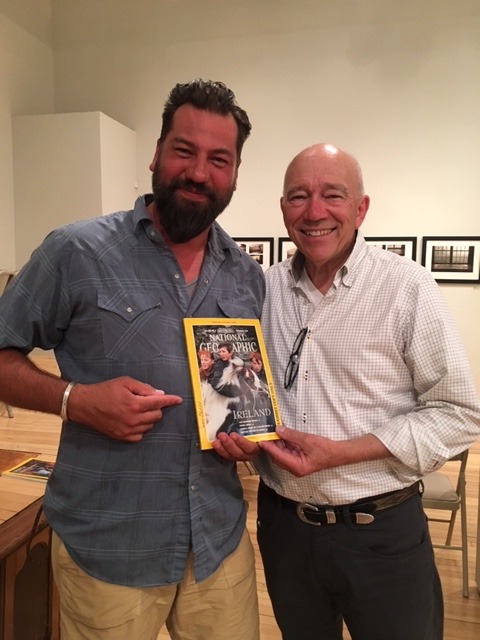
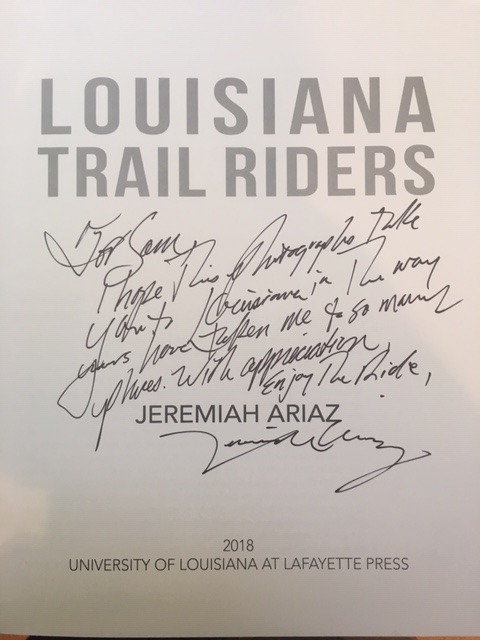
A chance encounter with, and a note of appreciation for, photographer Sam Abell. July, 15, 2019
Sam Abell was in Rockport, Maine where he’d given a photography workshop and was having an exhibition of his work. On the evening of my encounter he’d given a gallery talk reflecting on his life in photography. Now 74 years old, Sam had a lot to say.
The occasion for his presence and exhibition was a workshop he was teaching at the Maine Media Center. The modest audience, which appeared to be mostly his students, gathered in the gallery to hear the old master. Of the approximately 30 images in the exhibition he singled-out just four pictures to discuss, but in these were his acquired wisdom. Sam referred to a photograph of an owl flying above the horizon in the Artic. The image was made not long after the boat he was traveling on capsized spilling many rolls of his film and several cameras into the sea. He was taking a walk, brooding, when he came across an owl. They seemed to have startled each other and the owl flew away though cocked its head to make prolonged eye contact. Sam made one exposure. It’s dark, the focus is soft. It would never pass for a good “wildlife” picture- the magazine employs other photographers with those gifts. Still, the image captures how he felt in that moment and remains one of his favorite photographs. “You can teach someone how to make a picture but you can’t teach them how to feel.” Sam spoke about how growing up in rural Ohio he felt the horizon, always visible, was a sign of optimism. The line cuts through nearly every photograph in the show.
Sam discussed the influence of his soft-spoken father who taught him photography and the influence of his stern mother on his photographs that he only recently has come to realize. He pointed to his earliest picture in the show- a B&W 8x10 photo of silhouette of a man waiting for a train in a frozen landscape he made as a teenager and submitted to a contest, which he won. After making the photograph he made three prints – one that he owns, another is in the possession of a long-time friend (who lent it for the show), the last lives in a museum collection. The photograph, both the image and the gelatin silver print, are outstanding and point to his lustrous life to come as a picture maker. He spent 33 years working for National Geographic; mostly during the time I was discovering the world through the iconographic yellow-framed covers of the magazine. My grandfather had a nearly life-long subscription. He built two bookcases that created a wall between the dining and living rooms of the farmhouse with a space between them to pass through. These shelves were devoted almost exclusively to National Geographic. Older years of the magazine piled up in the children’s bedroom. At some point my grandfather gave a subscription to me. My mother still receives the magazine monthly. Some of the issues Sam shot cover stories for were on a nearby stage. I recalled each one. From my rural Kansas home I would look through the pages and dream of distant places. When I grew a little older I began to read the stories too. I frequently re-visited my favorite photo essays year after year. This was long before the critical reexamination of National Geographic that considered how it presented a colonialist gaze making an “other” of much of the world, especially that which wasn’t white. I suspect much of the distant world would have found my almost entirely white sparsely populated world on the Great Plains nearly as exotic. Still, it was the editors of the magazine that were shaping perceptions of those with little agency to tell their own stories for a global audience. The magazine has recently acknowledged, and sought to come to terms with, that history and vowed to do better. Regrettably, I no longer regularly see the issues and therefore can’t evaluate their progress. Though it had its faults, faults that reflected those of the nation, it was for me both an escape and education I’m grateful to have had.
After the talk Sam retreated to the side of the gallery to gather himself. I introduced myself, told him I was from rural Kansas and was very familiar with the horizon he spoke of. I told him how before I had any formal education in photography I had his photographs and those of his colleagues. They instilled in me a curiosity for the world that in the years since I’m grateful to have had the opportunity to explore. (My grandfather often said travel was the best education.) Sam’s photos also had a grace to them and demonstrated a man who seemed at ease in the world. He said during his talk that in making a photograph, “you and the world meet half way”. He was referring to how the photographer must prepare, consider all the surrounding elements, try to align them into an arresting composition, then wait for - in Henry Cartier Bresson’s words- “the decisive moment”. Sam has met the world, perhaps more than halfway, from his first assignment in Newfoundland in 1974, to the Arctic, to the Amazon, to … on and on around the globe. To me one of his most memorable stories was of cattle being branded in Montana. About fifteen years ago I was driving from Buffalo, NY to Kansas via Canada. I dropped back into the states in search of Laura Ingall’s Little House on the Prairie in South Dakota (after her stay in Kansas). Driving along a small desolate highway I passed ranchers in a field castrating and branding cattle. I turned around, parked off the pavement and went to talk with them and take some pictures. My camera then wasn’t very good and neither were my images- not on account of the camera but perhaps because I couldn’t shake the shadow of Sam’s images, which were one of the reasons I had stopped. My difficulty may have also stemmed from the squeal of a calf getting stuck with the hot iron or the plunk of its testicles dropping into a plastic bucket.
Sam wasn’t one of my “photography heroes”. When his images made the deepest impression on me I wasn’t much concerned with who made them and I had yet to have an art education. Then, I couldn’t have named any living artist. Later in college Sam’s name was never mentioned, his photographs never shown. He’s not part of “the canon”. But he’s made a life making pictures and those pictures have reached and inspired countless people and that is a beautiful, and artful, thing. Now teaching photography I frequently use his images and one of his books, “The Life of a Photograph” as educational references in how to construct an image. The book shows variations of his iconographic photographs, the moments before, or the moments after “the one”. It’s like being given access to his contact sheets and even better, access to his thoughts as to why he choose the image he did. This was also represented in the exhibition with multiple image variations on display and hand-written notes scribed in cursive on the exhibition prints.
I had a still shrink-wrapped copy of my book “Louisiana Trail Riders” in the car that I gave Sam as a token of appreciation. He asked me to inscribe it so I retreated to a window seal in the back of the gallery to do so. While the ink was drying he came over and thanked me again. I wish I could have been a fly on the wall when he looked through the pictures. We spoke for a while longer, pausing for a snapshot together.
It was a serendipitous encounter. At a restaurant for lunch in Camden, ME a few days earlier I picked up a postcard for the show with information on the talk. Coming down Cadillac Mountain in Acadia National Park earlier in the afternoon-then enjoying a peanut butter sandwich on the rocky cliffs over-looking the ocean- I had just enough time to drive the 1 hour 49 minutes south to Rockport to hear Sam speak. I parked directly in front of the little gallery and walked in. While I was in the bathroom washing the sweat off my face from the hike I heard him being introduced.
The world, which appeared so vast in the pages of National Geographic where I first saw Sam’s photographs as a boy, has subsequently proved to be quite small.
1 note
·
View note
Text
– ChiChai@Empire –
The universe brought my mom and I to Dubai in 2013. A company chose Project PEARLS as its benefactor for a gala and sponsored us to join. You can read about our visit to the Gold Market, Dubai Museum, Old Dubai, and Dubai Mall here. Since then, revisiting Dubai or the UAE itself has barely really crossed our minds. That trip was fast-paced and too glammed up for our taste (read about the gala here.) But, five years later, the universe decided we needed to go back.
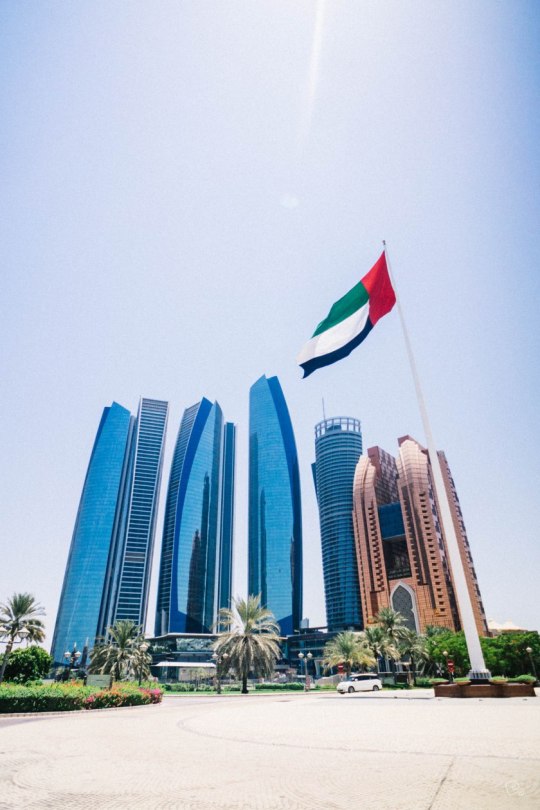
We travelled to the UAE for the first week of August. This time around, we grew a deeper appreciation for the country and were surrounded by loving company. The two cities we visited were Dubai and Abu Dhabi.
“The future belongs to those who can imagine it, design it and execute it.”
– HH Sheikh Mohammed, Vice President and Prime Minister of the UAE and Ruler of Dubai
Dubai
The Company
Why Dubai?
Ezra Santos – a couture designer and a Project PEARLS supporter based in Dubai – generously offered me one of the greatest wedding gifts that I’ll receive. (By the way, if you don’t follow the Empire Team personally, Chris@Empire and I are getting married this year lol.)
I won’t get into too much details about what that gift is or how beautiful it is or how much I feel glowed up like a princess who’s dreams are coming true. Instead, let’s take time to appreciate Ezra’s fashion studio and gallery!
Ezra not only welcomed us in his art space but he gave us that warm mabuhay-hospitality by treating us to a local eatery.

My favorite of the food was the dessert: kanafeh, an Arab dessert made of dough, cheese, and nuts meant to be drizzled with syrup. Mm!

He also showed us around La Mer — a beachfront that turned into an outdoor mall, theme park, public art space, and foodie spot.
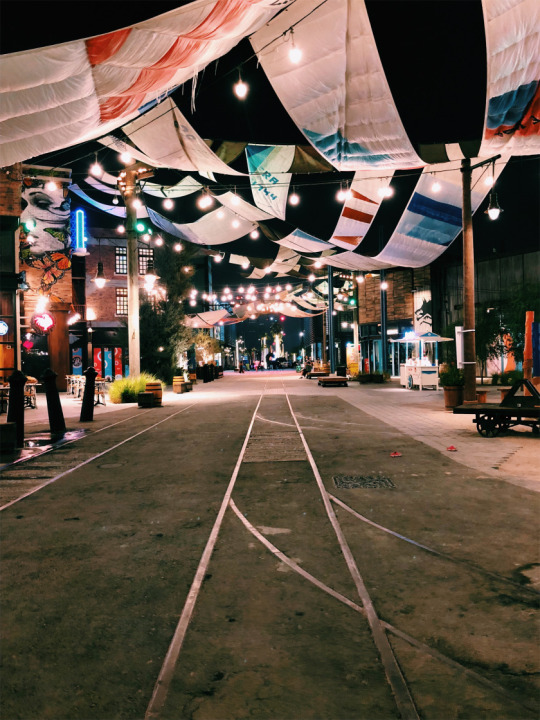
Some of my favorite murals were the following:
Another person that made our trip worthwhile was my cousin Pamela. This favorite cousin and airman of mine is currently stationed in Abu Dhabi. Lucky for us, her day off just so happen to coincide with our travel days!
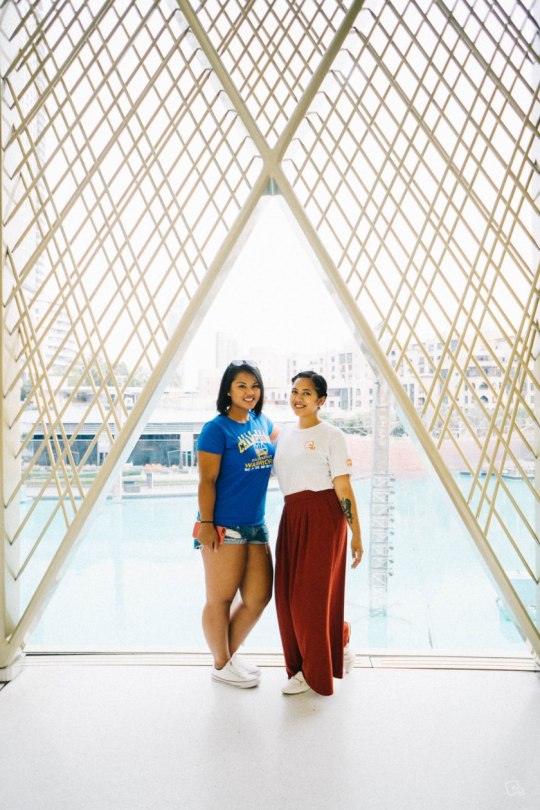
The Places
My mom and I realized that we saw maybe only 10% of the Dubai Mall in our initial visit. This time, we ended up spending hours in it… unintentionally. This mall just has so much going on! Here are some of my favorite views within the mall itself:
My favorite spot in the second-largest-mall-in-the-whole-freakin-world is the Kinokuniya bookstore.

We meant to only pass by it but ended up spending nearly two hours within the bookstore alone. They had numerous bookshelves for different segments of art (as supposed to one or two shelves like at Barnes & Noble.) Their amount of international literature was incomparable to bookstores I’ve gone too before — for adults and children!
Plus… it was toy galore as well.
My pick-ups included these must-reads from the political and social science section and… these wedding cake-toppers for Chris@Empire and I
The grandness of Dubai is shown in its metro stations as well. Here’s one near the hotel we stayed at:


Considering Dubai’s climate, plenty of air-conditioned walkways connect buildings to buildings. And, of course, even the views from those walkways were incredible.
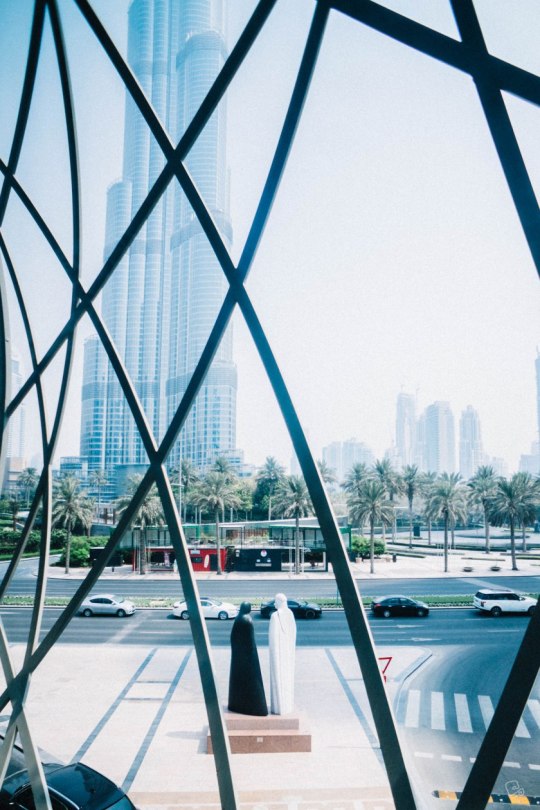
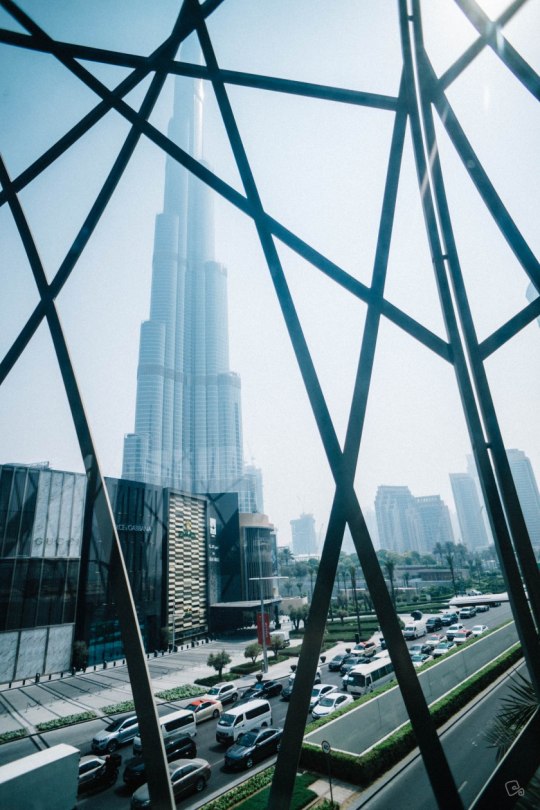
Abu Dhabi
My mom and I decided to dedicate a day to tour Abu Dhabi. We wanted to tour somewhere new since we saw Dubai’s major sites during our first trip. Within this one day, we visited the Sheikh Zayed Grand Mosque, the Emirates Palace, and the Louvre (yes! there’s a Louvre in Abu Dhabi!)
Sheikh Zayed Grand Mosque

The founder of the United Arab of Emirates — late Sheikh Zayed bin Sultan Al Nahyan — envisioned this mosque to become a unifying foundation for Islam’s cultural diversity with history and the modern world. (source)
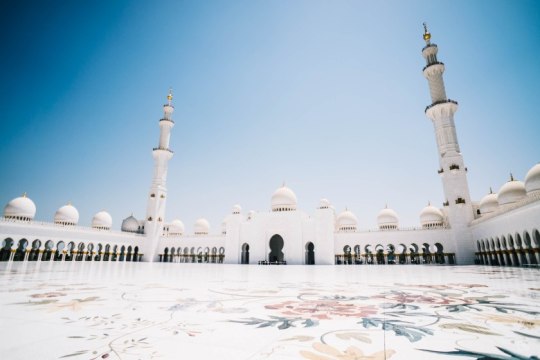
When visiting the Sheikh Zayed Grand Mosque, it’s easy to get mesmerized by the symmetry and the harmony of light and colors. I learned that the Mosque’s design plays a key role in representing its Islamic faith; Islam’s art is geometric, symmetric, and patterned in order to represent order and balance and to welcome those inside for contemplation.
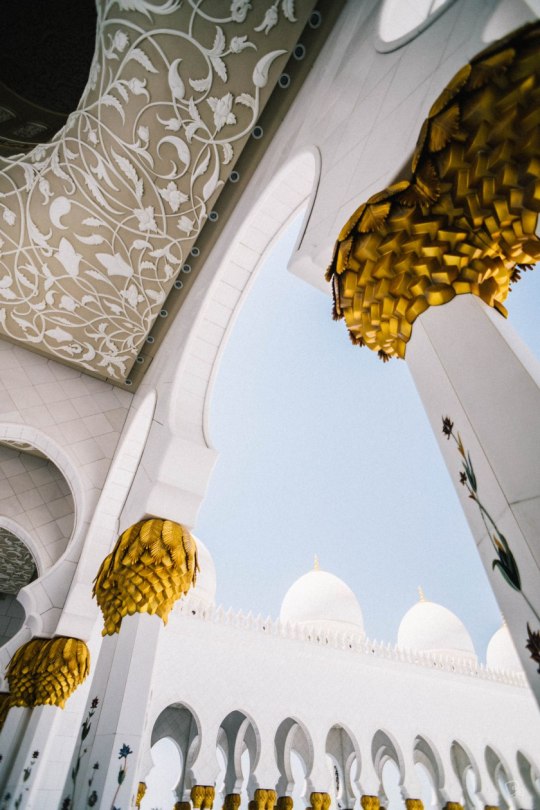
To treat every person, no matter what his creed or race, as a special soul, is a mark of Islam.”
“To treat every person, no matter what his creed or race, as a special soul is a mark of Islam.”
– Sheikh Zayed bin Sultan Al Nahyan

Emirates Palace
We thought, “Cool! Our tour guide is taking us to a palace!” Um. It turns out that the Emirates Palace is a hotel.

I’m pretty sure our tour guide here took us just so we can get photos in front of it. But that’s about all we got from it. Most of it was blocked off unless you were a guest (which costs about $300/night!?) Yup… Well, I suppose the tour guide was right. We got a few photos out of it.
The Louvre
See Humanity in a new light.
– The slogan of The Louvre – Abu Dhabi
Established in 2007, France and the UAE “came together to develop a new kind of cultural institution” that focuses on “universal human values.” (source) This institution became the Louvre.
Upon entering the museum, you are greeted by this quote by poet and scholar Jalal Al-Din Rumi
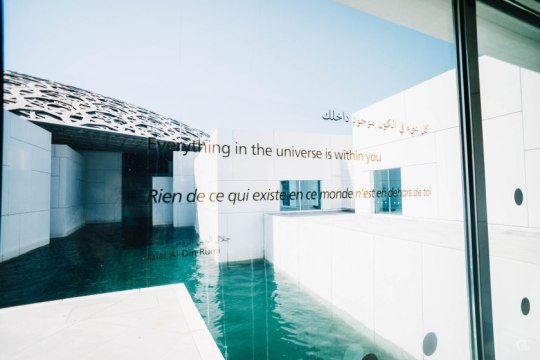
Everything in the universe is within in you
Many know the original Louvre as the world’s largest art museum. It’s beautiful, grand, and full of treasures from all over the globe. However, the history behind the French Louvre’s origins isn’t as beautiful. It began as somewhat a treasure room for royalty then became a prejudice art collector who “considered cultural traditions outside Europe to be of lesser quality, value, and importance.” (source) The introduction of art outside of Europe and Egypt into the Louvre actually didn’t happen until the year 2000!
The Abu Dhabi Louvre addresses the original Louvre’s fault of segmenting Europe and “the Other.” Rather than organizing the museum by region or Western art periods, the Abu Dhabi Louvre celebrates similarities among the world’s people by creating sections of “shared themes and ideas that reveal common connections throughout humanity.” (source)
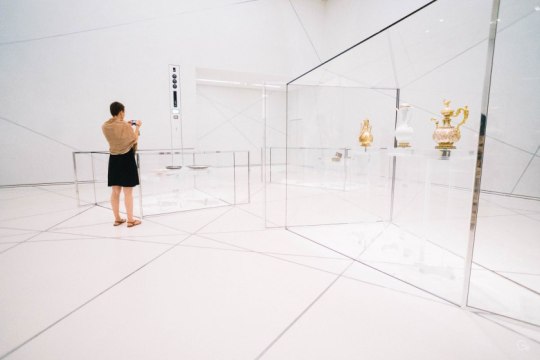
The artwork and relics were often paired or grouped in threes to show the similarities between different groups of people. For instance, this statue of “Orator” from Rome and Bodhisattva from Gandhara were both sculpted in 1st Century CE with the intent of a more natural look as supposed to stylistic and show the Greek influences that came to both areas in that time. Even the poses of the two are similar.
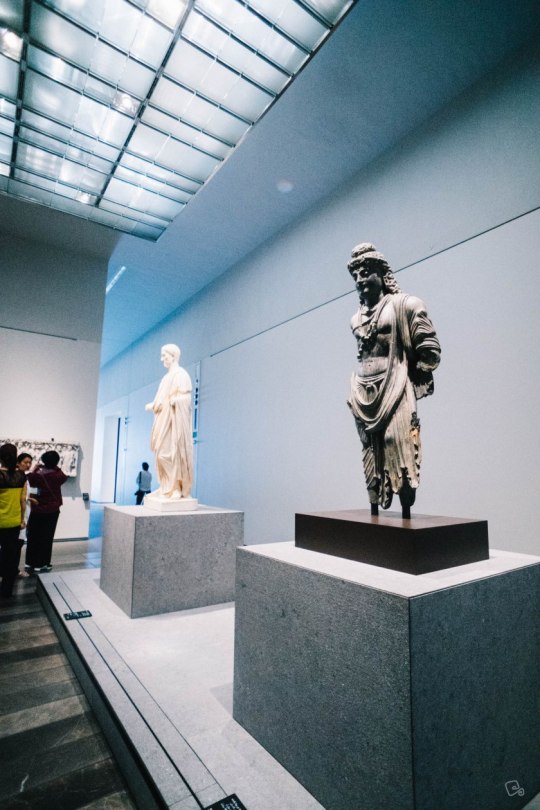
One of the themes I found most powerful was “Universal Religions.” As emphasized in the museum, what makes religions universal are the humans’ need and spiritual urge to create them and follow them.
In this photo alone, products of faith peacefully coexist with one another although belonging to different religions.
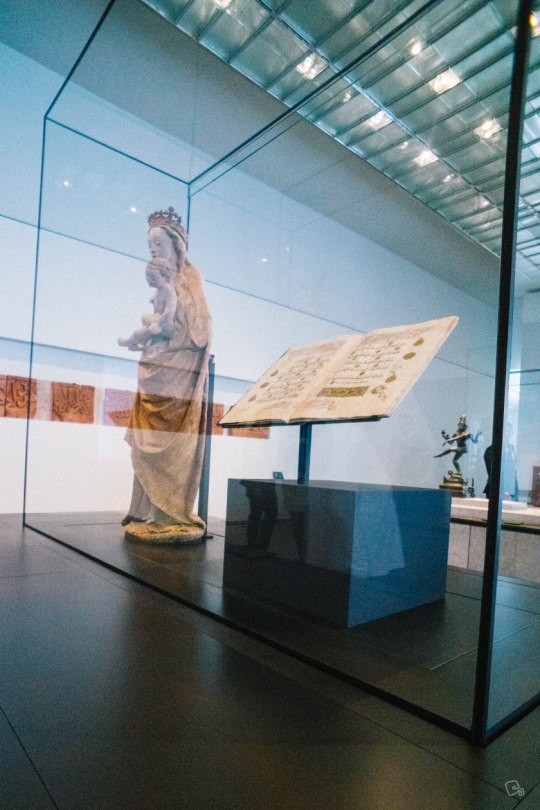
The most picturesque part of the Louvre’s architecture is the “Rain of Light,” a domed courtyard in which several light beams softly shine through.
ستأسر كلاً من أشعة الشمس وضوء القمر زوار متحف #اللوفر_أبوظبي مع شروق الشمس وغروبها. إذ سيسري شعاع النور في أرجاء قبة المتحف المصمّمة بعناية فائقة، مما سيسمح بتسرب الضوء إلى داخل المتحف مع توفير الظل للفن ومحبيه عندما يفتتح المتحف أبوابه بعد أربعين يوماً ⠀⠀⠀⠀⠀⠀⠀⠀⠀⠀⠀⠀⠀⠀⠀⠀ With the rising and the setting of the sun, #LouvreAbuDhabi's visitors will be delicately drenched in sunlight and starlight. The #RainofLight will shine through the museum's dome, bathing the museum in patterns made by the sun. We open our doors to the world in 40 days! #WorldArchitectureDay. ⠀⠀⠀⠀⠀⠀⠀⠀⠀ ©اللوفر أبوظبي – تصوير محمد سومجي ⠀⠀⠀⠀⠀⠀⠀⠀⠀ © Louvre Abu Dhabi – Photography by Mohamed Somji
A post shared by Louvre Abu Dhabi (@louvreabudhabi) on Oct 2, 2017 at 7:44am PDT
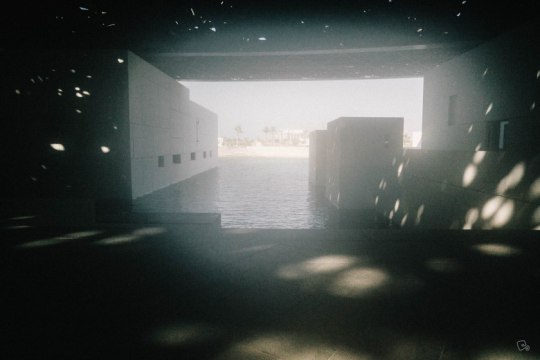
As you can see from the photo above… my lens got fogged up lol. Even my camera couldn’t handle the Louvre’s beauty. Luckily my mom was able to take photos with her phone:
Regardless of the photo quality/format, the brilliance of the “Rain of Light” is undeniable. If you are ever visiting the UAE, soaking in the sun-rays at the Louvre is already worth the trip.
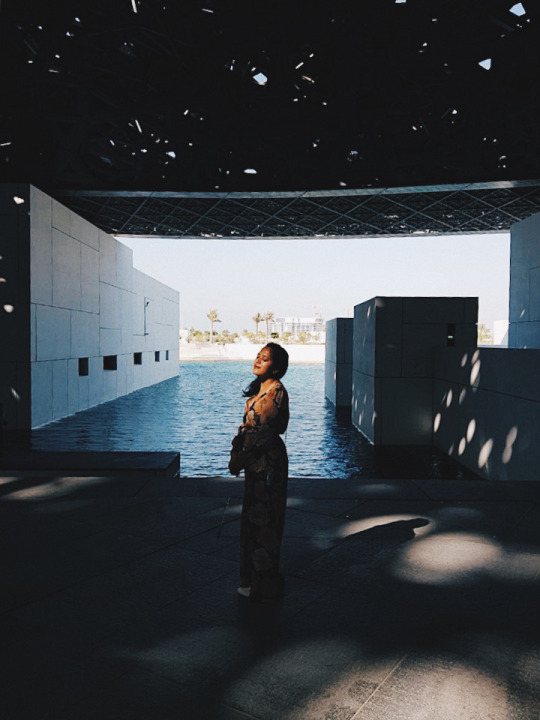
The travel blogging for this summer has just begun! Coming soon: Manila, Tagaytay, and Camarines Norte of the Philippines. To stay up to date on my travels (and behind-the-scenes of Empire!) visit my Instagram here.
ChiChai’s Reunion with the UAE - ChiChai@Empire - The universe brought my mom and I to Dubai in 2013. A company chose…
1 note
·
View note
Text
Nadav Kander - The Meeting
210220
Nadav Kander (Born 1961) is the first photographer that I cite in conversation about which practitioner has influenced me the most. He was born in Tel Aviv and based in London, although he does not regard himself to be British. His photographs are a part of the collections at the National Portrait Gallery and Victoria and Albert Museum.
Kander began taking pictures at 13 years old with a Pentax camera. In the South African Air Force, he processed film and printed aerial photographs. In 1986, he moved to London where he currently resides with his wife and three children. Portraiture and landscape photography are the main genres that he is best known. I have an appreciation for the consistency in his career, which has traversed 30 years across fine art and commercial platforms. He has photographed celebrities, models and a multitude of other sitters. In 2009, his 52 portraits published in The New York Times Magazine portrayed President Barack Obama and his closest associates. It is the largest portfolio of work that the publication has ever showcased. Later that year, Kander was awarded the prestigious Prix Pictet Earth for Yangtze - The Long River (2008). The shortlist of nominees included Ed Kashi, Andreas Gursky and Naoya Hatakeyama. The list of his other awards is extensive and includes a World Press Photo Award 2013 and 2014, Honorary Fellowship from The Royal Photographic Society 2015 and Outstanding Contribution to Photography from Sony World Photography 2019. (Lens Culture, 2020)
During the World Press Photo Exhibition 2014 at the Southbank Centre, London, I was particularly taken by Kander’s 3rd Prize entry of actor Chiwetel Ejiofor. The photograph first appeared in New York Magazine as a staged portrait to commemorate the British actor. Ejiofor, played a black man kidnapped in 19th Century America and sold into the slave trade in the film 12 Years a Slave (2013). He received an Oscar nomination for the role and won Best Actor at the BAFTA awards. Actors have a trained ability to respond to a camera. He appears poised yet relaxed. Kander’s characteristic turquoise key light is apparent with a red back light to highlight the outline of the sitter. The lack of a fill light leaves a proportionate amount of this face in an enigmatic shadow. This low-key lighting design gives the photograph a sombre tone. Emphasis is placed upon Ejiofor’s eyes, which reveals the complexity of his role in the film. As a viewer of the work in person, I felt a closer affinity to the subject when it was close to life sized. Its considered forms had a significant presence akin to a drawing, painting or sculpture. (World Press Photo, 2020)
The Meeting (2019) is a book that acts as a homage to Kander’s career, with photography from his early foray into the genre to illustrious works recognised within the fine art and academic communities. The annotations add insightful anecdotes about each piece and the man himself. The opening, entitled ‘The Triangle’ outlines a relationship of personal interest to me between sitter, photographer and viewer.
‘I don’t photograph to tell stories. I photograph to make stories. The viewer, if they hold their gaze long enough, becomes the author of the work’s meaning.
Consider there’s a metaphorical suitcase packed with white, grey and darker clothing that we carry around with us wherever we go. When we meet someone, we choose what items to show; maybe only clean white shirts, perhaps darker one. This unpacking is symbolic of a meeting. Much like when I work with a sitter. Our stories collide and change depending on the day, the weather, our emotional states.
If I manage to make a portrait that stirs a viewer then they complete what I call ‘The Triangle’ by bringing their own story or state of mind to the picture. This is fundamental to me, but often missed or misunderstood, because photography is still considered by many to be a record of an event. It is that; but it is not only that. How can it be?
Perhaps if we replace the word ‘photographer’ with ‘poet’ the point becomes clear. It is accepted wisdom when it comes to poetry that every individual reader finds his or her own meaning in the poem and this perspective is unique - no more less valid that yours or mine. The same, in my view, is true of photography.’
In email correspondence between 4th and 28th April 2019 with David Campany, Kander describes his photographic process. These extracts resonated with me as a practitioner of portraiture and landscape photography.
NK - I’ve walked down one road since I started photographing when I was 13. I feel I haven’t deviated at all. I still need my work to strike the same chords in me that I’ve always longed and striven for. My photographs (however varied a viewer might find them) come from the same inner place. I seem to revisit a slowed-down reality, which is very beautiful and important to me. Slow, quiet and slightly uneasy, alluding to more going on beneath what you first see. The subconscious need to express what feels meaningful and profound never goes away. I just try many ways to revisit it, to come at it from different directions.
DC - The portraits you’ve made seem to have quite a special place in your work. As if a face, or a person, is a way to get to the tension between surface and depth. I feel the human face is somehow already an image before it’s photographed. It’s already a kind of presentation, or representation of the self, although a very fragile and elusive one.
NK - That is beautifully put! Yes, my photographs of people are an essential part of my practice.
They follow on from my photographing landscape. When first dealing with landscape I realised it wasn’t the natural environment I was after, but the man-altered landscape. I focused on a darker nature, our destructive ambivalence to our surroundings, but I shrouded these scenes in beauty using compositions that, purely from their form, colour and weight, would have an effect on me apart from the information shown.
DC - Portraiture is often thought of as a two-way exchange, between photographer and sitter, but you’ve talked often of the viewer being crucial to meaning. That said, there’s a real intimacy to your portraits, as if these people have been given the freedom to forget their audience momentarily. We viewers can look, without feeling we’re being performed to. Is this how it is?
NK - I’ve had to think a long time about your question. Much of what I do is intuitive so finding the words is difficult. When I’m in front of a person (or a landscape for that matter), there’s nothing in my head that matters. I’m just looking with so much concentration that sometimes it feels as if I might explode. I do not want to be stirred so badly! All I want is for something to show itself, something that if I release the shutter will become an image that will stir me and unsettle me. To get close to this I must direct people very softly, subtly, and create the appropriate light so that they experience something of themselves. Any frivolous act for the viewer will never work; it would appear transparent. It has to be just for them and me. Only once this is successful does the viewer enter and make up the triangle. Artist, subject and viewer - each one a part of the whole.
From beneath the surface beauty, comes an existential call that touches on questions of destiny and the unknown. The works of Hans Bellmer, Man Ray, Raoul Hausmann, Dalí and Hans (Jean) Arp have also had a big influence on me. Although my work is not surreal, the feeling I get from the work of these artists is something I always search for. For example Jean Arp’s sculptures were very informative when I began photographing the nudes that became the series ‘Bodies - 6 Women, 1 Man’.
DC - It’s interesting that you put it that way. Very often I find myself wondering what landscapes your sitters were in just before they came to you, what it was - out there in the world - that is on their mind as you make the photograph.
NK - A portrait is one way of looking at some facets of our condition. There’s a precious and beautiful flicker of understanding, or the opposite, that shows itself for short periods and disappears. These periods, which I must see and try to photograph, are often responses to the light or the atmosphere that the light imbues. I must try to recognise them as an image that has what I love; depth of feeling, vulnerability and poise, pride and soul, a recognition of something more than just this moment now. Little of this clear to me, but this is the best I can do to explain it. (Kander, 2020)
Summary
It is an inevitability that a photographer emulates their heroes. Whenever I read that someone like Kander also had starting points for their practice, I am encouraged. I have covered in detail the practitioners that have inspired me for this project - Smith, Andrew, Refn, Sigel and Norwood. There are blog posts committed to each of them. However, I felt that Kander required more substantial meditation. There are parallels between his voice and my own - low key lighting and moody colour saturation delivered with a quiet temperament. He reveals that these attributes are the reflection of triangles that he forms between himself, his sitter and viewer. A sitter may choose to present themselves in any number of ways to his lens then this narrative is open for further interpretation by anyone that encounters his imagery. During his interview with Campany, he explains that he implements soft direction, free of frivolity to search for each photograph. He also explains a slow and quietened reality that he occupies beneath the surface appearance of what he sees.
The Ejiofor portrait inspired me during a formative stage of my photography. There is overlap with the other photographers and cinematographers that I have mentioned. Low key lighting is a continuous theme; however, Kander’s renderings have more depth. He is reluctant for media attention and I found The Meeting (2019) to be highly enlightening. His is the work of a ‘poet’ acting as a ‘photographer’, to use his own metaphor. As an analytical student, I have attempted to dissect what makes Kander, Kander. An awareness of his process is just the beginning. My lighting will resemble his, in addition my direction style is already collaborative instead of dictatorial. Any additional intricacies are unique to his voice. As I develop as a photographer myself, I am hopeful to have as reputable career and recognition. There are plenty more triangles that I am eager to construct.
Bibliography
Kander, N. (2019). The Meeting. London: Steidl
Lens Culture (2020). Biography. Lens Culture. Available from
www.lensculture.com/nadav-kander
[Accessed 10/04/2020]
World Press Photo (2020). 2014 Photo Contest. World Press Photo. Available from
www.worldpressphoto.org/collection/photo/2014/29789/1/2014-Nadav-Kander-PS3
[Accessed 10/04/2020]
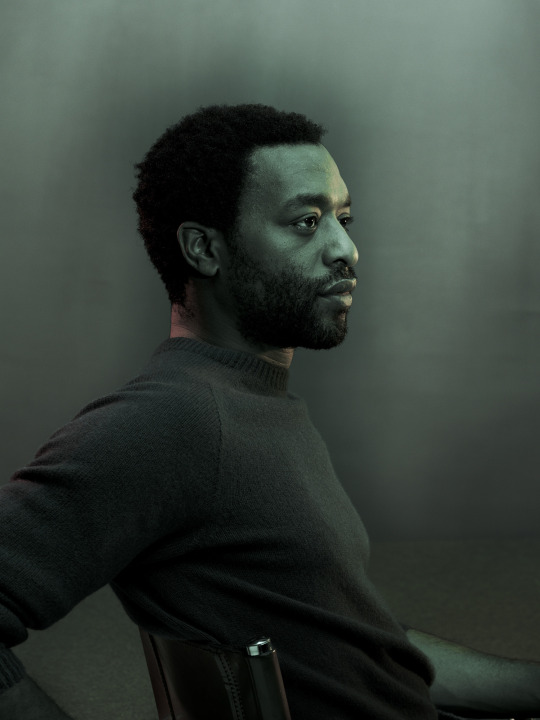
Nadav Kander, Chiwetel Ejiofor, 2014
0 notes
Text
Belgrade sights - 11 most interesting places
New Post has been published on https://tripsterguru.com/belgrade-sights-11-most-interesting-places/
Belgrade sights - 11 most interesting places

Serbia is a multinational country with a rich and complicated history. The territory of the current state includes lands previously owned by Hungarians, Turks and other peoples. Its culture was affected by the influence of East and West. The capital city of Belgrade, unlike many European capitals, is quiet and calm. The houses of the cobbled streets of the old quarters are like doll houses. The new areas, with their dilapidated walls, remind of Yugoslavia and military aggression by NATO. The nature of plains and plateaus is rich in greenery and full-flowing rivers.
Belgrade fortress
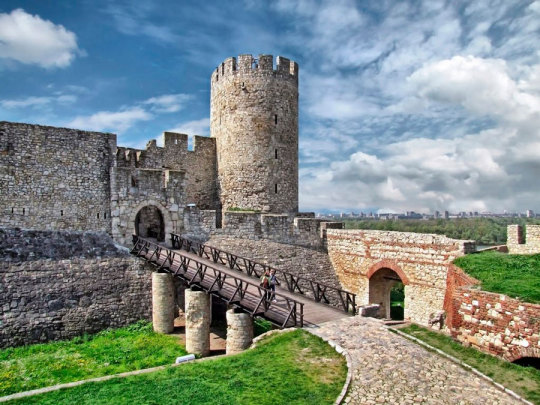
Belgrade Fortress is located in a picturesque place where the Sava River flows into the Danube. Strategically important location determined the fate of the citadel. Like the confluence of two water streams, the economic, political and cultural paths of the East and West converged here. Fierce battles were fought hundreds of times for fortification; tens of times its walls were partially or completely destroyed. Nowadays it is peaceful and calm, because now it is one of the most significant historical monuments for Belgrade. The Belgrade fortress was built 2 millennia ago from white stone, where the name of the city came from. High fortified walls are adjacent to the large cozy park Kalemegdan. The word is translated from Turkish as “battlefield”.
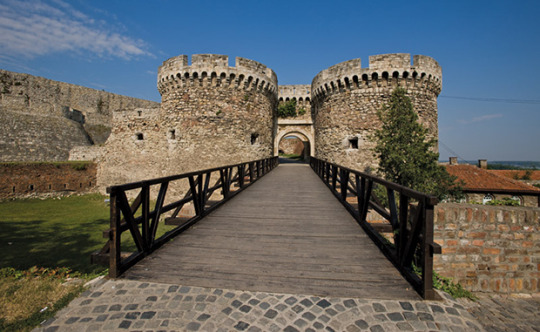
The Turks called the stone fortification a “hill of thoughts”, which corresponds to the atmosphere of peace reigning here. The name of the garden Kalemegdan was assigned to the citadel. Within the walls of the Belgrade fortress are 12 gates, the main of which are Istanbul. Walking along the pedestrian street of Prince Mikhail with its bright shop windows, you will find yourself in Kalemegdan. You can also get there by public transport.
Entrance to the territory is free. Of interest to tourists is not only the fortress, but also several museums, existing churches, towers, statues and the Roman well. For 10-15 euros you can join the tour and learn more about the centuries-old history of this place, its myths and legends. Capital residents have chosen Kalemegdan for relaxation.
A fascinating view of the city opens from the observation deck. On holidays, concerts and festivities are organized on the territory of the park, and on weekdays you can sit in a cafe or just eat ice cream.
Belgrade Zoo
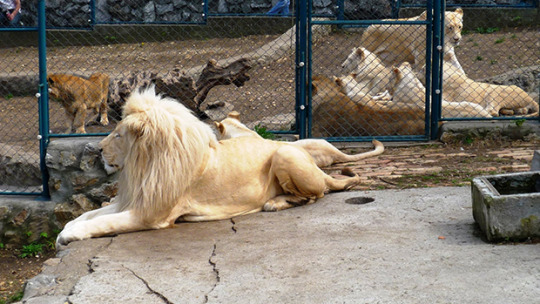
The walls of the Belgrade fortress are conveniently located a spacious zoo with the saying “Park of good hope.” In its history, it was bombarded three times: twice during the Second World War and in 1999 during the armed conflict between NATO and Yugoslavia. In memory of those days, the zoo got its bright name, and its leadership seeks to keep pets in the most comfortable conditions. The zoo is home to more than 2 thousand individuals of 270 species of animals and birds. At the same time, they are looked after properly: the freedom of pets is almost unlimited, and their cleanliness pleasantly surprises. Feathered walk along the paths of the zoo. In a special pavilion you can play with lambs, kids and others.
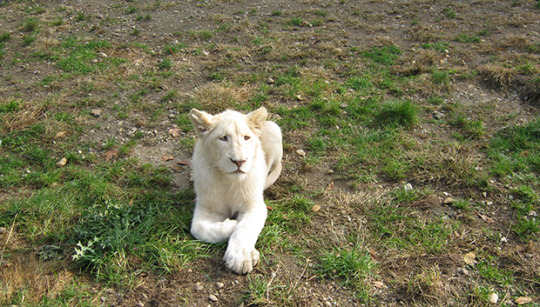
The zoo of Belgrade distinguishes several of its attractions from the rest. Since 1986, special attention has been paid to albinos. Animals with a white color are collected around the world as a symbol of the “white city”. In the year of the last shelling, a baby elephant was born in the zoological garden. He was given the nickname Rambouillet by the name of the city in France, in which peace talks were held regarding the situation in Kosovo. Veteran of the zoo can be considered the world’s oldest alligator Muya, who appeared here in 1937. The menagerie meets its visitors from 8.00 to 19.30 in the summer, and until 17.00 – in the winter. Ticket sales end a little earlier. The cost of visiting: 400 Serbian dinars (about 4 euros) from 15 years, 300 dinars (3 euros) – from 3 to 15 years. To avoid confusion, carry cash in the national currency and do not give food to animals. After the death of a giraffe through the fault of visitors, the size of the fine for feeding animals was greatly increased.
Princess Lyubitsa Palace
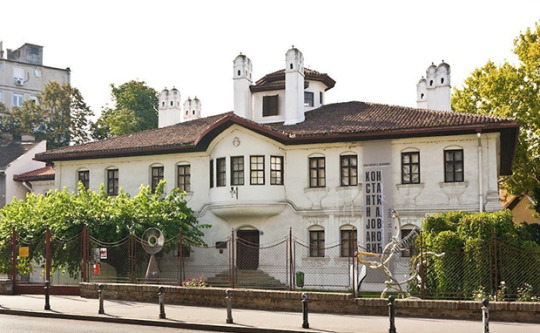
How do you imagine the palace for the princess? In fairy tales it is described as a high castle surrounded by two-meter walls. But in life, everything is a little different. One of the most beautiful buildings of the old city is the palace of the princess (she is also called the princess) of Lyubitsa. The low-rise house, traditional for Belgrade, in white, was erected in 1830 by decree of Prince Milos Obrenovic in the place of their old dwelling. In the new building made 3 floors, one of them is a basement. On the second floor next to the princess’ chambers, a hammam was arranged. Over a two-century history, the palace has changed several destinations.
At different times, it housed a lyceum, a court, a boarding school for the deaf, various museums. At the end of the 20th century, the building was declared a cultural monument and restored. Now the former residence of the wife of Prince Milos is part of the Museum of the capital of Serbia. The palace is valuable in that its architecture, layout and interior decoration are an excellent example of the combination of eastern and European culture of the 19th century.
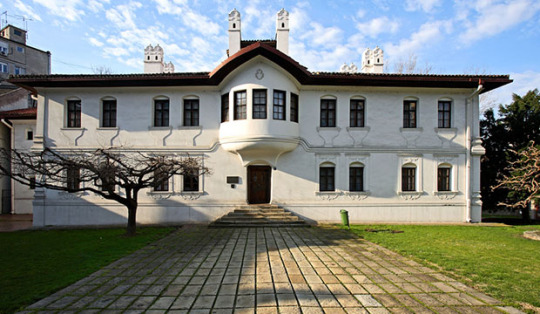
The museum’s collection consists of furniture and art, personal items of the princess. Here are excursions with the saying “Coffee with Princess Lubitz.” The museum keepers will not only tell the history of the palace and the life features of the ruling family, but also treat them with strong Turkish coffee with Turkish delight. In the basement periodically informative lectures of cultural and historical subjects and creative evenings are held. The cultural monument is located in the old part of the city near the Kalemegdan fortress. Ticket price will be 200 Serbian dinars. There are discounts for students. The museum is open from 9 a.m. to 6 p.m. Day off: Monday. The exhibition is allowed to photograph without the use of flash.
St. Sava Cathedral

In Belgrade, white is an unofficial symbol of the city. On the hill Vračar in the center of the Serbian capital rises the majestic church of St. Sava of Serbia, built of white marble. According to Christian canons, the sanctuary is not a cathedral, but thanks to its impressive size, this name was entrenched in the people. It is one of the largest Orthodox buildings in the world. Its height is 82 meters, 18 crosses crown the bathing, 49 bells fit in the bell tower. Indoors, at the same time, 10 thousand believers can be present, the choir is designed for 800 singers.
The landmark has no centuries-old history, but a monument was erected on the site of the burning of the relics of St. Sava according to the prototype of St. Sophia Cathedral in Constantinople. Planning for construction began in 1894, and the “first brick” was laid only 40 years later. Since 2004, the temple is considered open to parishioners; it still has not completed the interior decoration. It is worth a glimpse for the sake of the huge and amazing mosaic of Jesus Christ, located under the central dome. Finding the Cathedral of St. Sava is not difficult. It is located in the center of Belgrade on a hill and majestically rises above the city. Around the temple is a cozy park, nearby is the National Library of Serbia.
Museum of Nikola Tesla

Each nation has its own heroes. The Serbs are proud of their great compatriot scientist, whose work has had a tremendous significance on the development of science. The only official museum of Nikola Tesla is located in a small mansion in Belgrade. Even if you have no idea who this man was and why he is considered a great physicist, be sure to visit the museum. Here, an excursion takes place every hour, the first part of which consists of a short video and a short guide story, the second part is much more interested in demonstrating the experiments once conducted by the inventor.
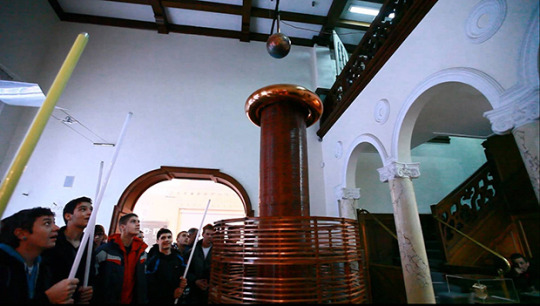
During the experiments, everyone can feel like a Jedi and an illusionist. The glowing “sword” and lightning from touching the Tesla coil are real phenomena that were subsequently shown in films and computer games. In addition to the exposition of various equipment for experiments, the exhibition has a collection of personal items and original documents owned by Nicola Tesla. Among other exhibits is a urn with the ashes of a scientist. The museum is open from 10 a.m. to 6 p.m. from Tuesday to Sunday. For those who understand the Serbian language, the tour will cost 250 Serbian dinars. For English-speaking tourists, the cost will be 500 Serbian dinars, and for groups of 10 people – 300. For children under 7 years, admission is free. The mansion is located in the central part of Belgrade at the address: ul. Krunska 51.
House of flowers

The flower house in Belgrade has an indirect relation to floristry, in fact it is a mausoleum in which the bodies of former Yugoslav leader Josip Broz Tito and his last wife rest. The memorial complex was originally a greenhouse in the residence of the Marshal. In his free time, Tito liked to plant flowers and take care of the garden. Now silence and tranquility reign in the pavilions, trees grow, bizarre statues stand. You will not find an open coffin with an embalmed body, only a memorial plate. In the tomb is a small museum of Josip Tito. His collection includes some personal items and numerous gifts received by the former president from officials. The mausoleum is often not crowded. On the birthday of the father of the people on May 25 and on the day of his death on May 4, the memorial complex is visited by the family, friends and comrades of Josip Broz Tito. The flower house is located on the outskirts of the city. Nearby is the Museum of the History of Yugoslavia. You can get to them by trolleybuses that run along routes No. 40 and 41. Mausoleum opening hours: from 10.00 to 18.00. Day off: Monday.
Ticket price: 300 dinars (approximately 3 euros).
Quarter Skadarliya
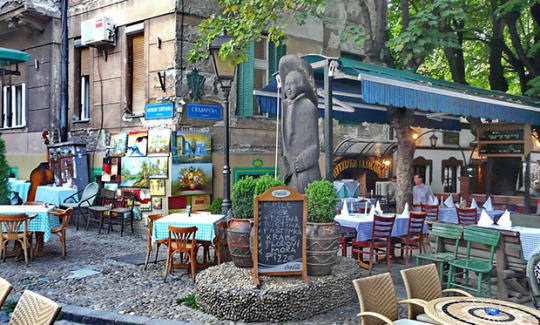
Being in museums, having seen enough of various sights of the capital of Serbia, it is pleasant to walk along a quiet street, to sit in a cozy restaurant. In Belgrade, its old part, there is a small region of Skardalia, which is considered to be Bohemian, and travelers compare it with Parisian Montmartre, Odessa Deribasovskaya, and Moscow Old Arbat. On a street with a stone pavement, it is deserted during the day. Toward evening, street artists and musicians appear here, selling souvenirs and trinkets from the stalls. There are antique shops in Scardalia, where you can plunge deeper into the culture of the Serbs. The oldest restaurants in the city are also located here. To live music in a cozy atmosphere you will get acquainted with the national cuisine, hearty and varied.
Initially, the area was inhabited by people with creative professions, they were attracted to inexpensive apartments and delicious food in neighboring cafes. Writers, poets, actors and dancers created an atmosphere of constant celebration in the quarter. This light mood is still in the air. The brick walls of low houses are painted like canvases and decorated with fresh flowers. The Skardalia quarter is easy to find in the Stari Grad community nearby the Republic Square. Tourists are advised to carry Serbian dinars in case you should decide to buy some souvenirs or have dinner. Girls should not shoe high-heeled shoes and thin stilettos.
Gardosh Hill and Millennium Tower
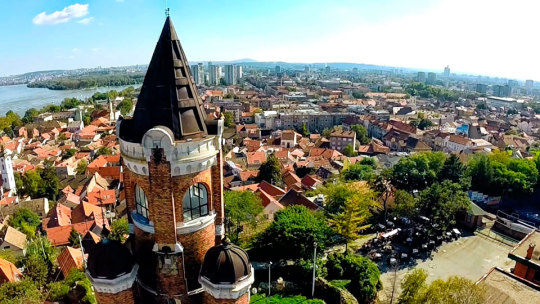
In order to look at Belgrade from above, you don’t need to parachute or fly by helicopter, just climb to the observation deck of the Millennium Tower (also called the Yanko Tower), towering on Gardosh Hill in the ancient Zemun district. The building, 36 meters high, was built in the 19th century, when this land was part of Austria-Hungary. The government erected a monument as a symbol of the millennium of the settlement of Hungarians on the banks of the Danube. Hence the name of the tower. It makes sense to climb Gardosh Hill not only for the panorama of the city. Walking to the hill on Zemun will be a pleasant pastime both in the morning and in the evening. The tower is open around the clock and admission is free. For 15-20 euros, you can join the tour with a Russian-speaking guide.
The old quarters can be reached by buses coming from the city center. Routes Nos. 704, 706 and 707 lead here. The closest Zemun Pochta stop is to the tower, but you can get off earlier and take a walk along the narrow, winding bridge past the toy houses to the stairs on Stara Visoka Street. You will be taken to the Millennium Tower. On the way to the hill you will find several small churches that add color to the bedroom area, which has preserved the best traditions of Europe. A road leads to the hill from the picturesque wide riverbed of the Danube, along which the city promenade stretches with an alley, benches and stunning views. Not far from it there are several small restaurants and cafes in which they cook deliciously at home. On the menu, pay attention to dishes of fresh fish caught in local rivers.
Avalan TV Tower
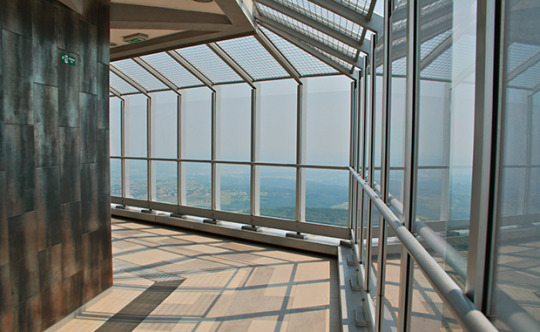
The Millennium Tower in the old quarter of Gardosh is an authentic monument of Slavic culture. A more modern high-rise building in Belgrade, which majestically rushes into the sky of the capital, is the Aval TV Tower. The attraction is of interest to tourists for several reasons. Firstly, there are no buildings above it on the Balkan Peninsula. Secondly, all over the world there are only a few buildings for which the basis is an equilateral triangle. Thirdly, the tower was completely destroyed during the military conflict with NATO in 1999. It was completely restored and in 2010 is open to the public.
Aval TV Tower is located outside the city on Mount Avala. Near it, 3 monuments of different times were erected. You can get to the place from the capital by regular buses No. 401, 403 and 405. In the summer, on the weekend, an additional route No. 400 is launched. The cost of visiting the observation deck is 200 dinars. For 400 dinars, you can buy a ticket that includes a drink in the restaurant located above. The height of the TV tower reaches 205 meters, and the exit to the site is at a distance of 119 meters from the ground. Here the wind blows and is cool enough, so sitting at the cafe with a cup of coffee or hot chocolate will be more pleasant to watch the panorama that opens. Aval TV Tower greets its visitors daily from 9.00 to 20.00.
Skyscraper Genex

The second tallest building in the Serbian capital is the Genex skyscraper, also known as the “West Gate of Belgrade”. Its highest point is 140 meters. The bizarre, futuristic structure was designed and erected in 1977, when Art Nouveau and brutalism dominated the architecture. The skyscraper consists of 2 buildings of 35 floors, connected from above by a two-story bridge with a rotating turret.
Inside this design is a restaurant. Be sure to dine in it if you are not afraid of heights. From the windows of the institution offers a bewitching view of the western part of Belgrade. Due to its originality, the complex is perhaps the most memorable in all of Eastern Europe. Some publications include him in dozens of the most unusual skyscrapers in the world. The house received its unofficial name because of the Genex company, which occupies one half of the skyscraper. To get to the sights, use buses number 65, 74.
Fortress Vrsac
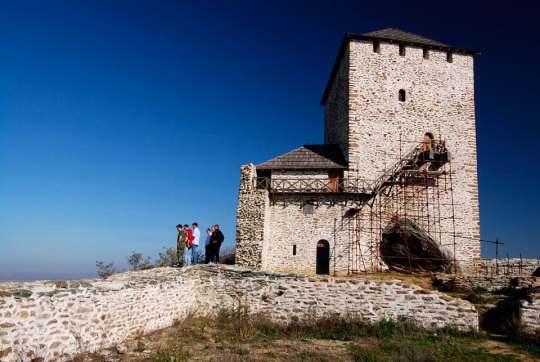
One of the oldest military fortifications in Serbia is considered a fortress with the unusual name of Vrsac. It is located at the foot of the Carpathians to the west of the border with Romania. The citadel was built in the 15th century during the Turkish wars from granite and mica, therefore, after reconstruction on sunny days, its walls seem to glow. The fortress rises high above the city that grew next to it. The heroic history of the Serbian army is reflected in the coat of arms of Vrsac. The distance from Belgrade to the fortress is about 90 km. Going here just for the sake of the fortress is not worth it, only the castle and several fortress walls remained intact. Set aside a day to explore the ancient city of Vrsac and its attractions.
The historical part of the city is attracted by such architectural monuments as St. Nicholas Cathedral, “Vladichansky Dvor”, St. Gerhard Cathedral and the City Hall. In the vicinity of Vrsac there is the Monastery of Mesic and the town of Bela Crkva. A tour of the historical sites can be diluted with a visit to the winery and a tasting of local wines. Public transport runs from the capital of Serbia to the city of Vrsac. In order to have time in one day to see all the important historical monuments of this part of the country and visit the vineyards, it is better to use the services of guides. The price of the tour depends on the duration of the trip, the route and the number of people in the group.
#Avalan TV Tower#Belgrade fortress#Fortress Vrsac#Gardosh Hill and Millennium Tower#House of flowers#Museum of Nikola Tesla#Princess Lyubitsa Palace#Quarter Skadarliya#Skyscraper Genex#St. Sava Cathedral
0 notes
Text
Health Benefits Of Pearl Powder
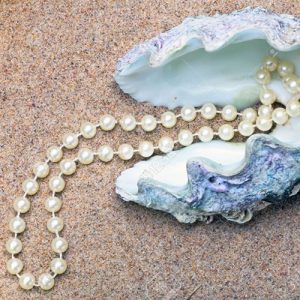
Bright and glorious pearls in jewelry next to the image in the field of Health knows very few people that have healing properties. Most of them are regarded as jewelry or precious stones, although it can be made into a fine powder to be used for health care. Chinese people since ancient times, the ornamental use typical, except for use in the field of Health also known is a secret. Former Health Secret Almost every ancient civilization in the benefits of pearl powder are well known. Medication and cosmetics in China as the use extends to at least 320 MS and here by the emperors sought a healing source. Even the pressure of the emperors to exist even if he was doing it. It is mentioned in medical books of the Ming dynasty, as to promote healing and skin regeneration, expel toxin, was used to correct sun damage and age spots. In India, Pearl Powder have been used in Ayurvedic medicine. The Pearl is known to increase the overall strength and health is a component of love potions and is often among the details that. In medieval Europe it is widely understood that pearl powder also have therapeutic qualities. German and English works of the seventeenth century, and claimed that physical and mental effectiveness under various conditions, and at the same time he was also a famous philosopher scientist Francis Bacon, has proposed as a means for lengthening the life of. Health Benefits Of Pearl Powder 1.Life extension: prolonging the life expectancy of both humans and animals in various studies in pearl powder, which are effective antioxidants and stimulates the production of biochemicals hopeful about and came to conclusions. Silk beetles, mice, nematodes (roundworms), and pearl powder diet supplemented with fruits, according to studies by in some cases 50% or more, it was observed that the life time of significantly increased. The study in The Shape of animals and humans is complex and life prolonging properties, especially superoxide dismutase (sod) and glutathione (antioxidants, especially superoxide of two) is a result of it is believed that the ability to retrofit. Both of these antioxidants in the body, the connection is strong with long life. The course of the disease especially in the back of many effective DNA protection and repair and that help has been found in studies to prolong life has been found. Also measurable, prolonging life and promoting health which is associated with the Mao-B inhibit both enzymes.
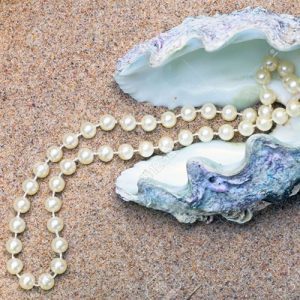
This powder also affects the various components of DNA and RNA metabolic activities, and thus cell regeneration and growth can support. Early human clinical studies generally show very positive and promising results, although further work is required to be carried out on this topic. 2.Skin and bone renewal:the scientists studying the health benefits of pearl powder a special item called psoriasis the new skin, collagen and fibroblast and osteoblast formation, which is required for the regeneration of bone tissue that can cause have found. Fibroblasts, our muscles, our skin and the connective tissue that surrounds our organs that are abundant in “constructive stem cells.” Pearl, mother-of-Pearl actually, fibroblast regeneration by improving the form of your body to keep your muscles and can help strengthen your organs. Fibroblasts, wound healing faster a substance that gives the skin brightness and youth back. In addition, the skin wrinkles, while reducing the harmful effects of the sun by increasing skin elasticity and prevents sagging and other signs of Aging which could cause the formation of new skin cells and collagen stimulates the skin's firmness. Osteoblasts are responsible for new bone formation and stem growth. Museum d'histoire Naturelle in Paris in 1992, has examined the osteogenic properties containing psoriasis. Human Osteoblast psoriasis during the study was placed a layer of chips. Psoriasis of osteoclasts, which are close to the chip and then they pile they found themselves tied into the chips. Even more surprising thing, has created a complete new bone osteoblasts in the presence of an array of psoriasis. Psoriasis is what is causing this, we can understand how, for those wondering, the chips are only psoriasis has caused such minerallesmey surrounding osteoblasts. In 2003, the same group of French scientists decided to research Pearl fills in the gaps in the lumbar spine of sheep and psoriasis experimental pieces are placed. This psoriasis is the placement of filler adjacent to implant the newly created psoriasis have found that is induced by the production of a layer of bone. In addition, psoriasis causes increase in bone mineralization discovered that the placement of the sheep.
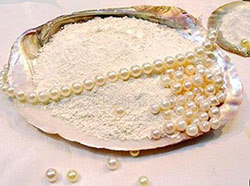
One of the benefits of pearl powder on the planet is one of the most rich sources of calcium, and the weight 80% or more calcium. Not only that, but also a human clinical study in psoriasis comparing ni bio human and animal studies other calcium supplements, conventional calcium carbonate pearl powder is absorbed twice as much of supplements. The most common of these diet supplements in the form of calcium. Scientific tests, calcium and naturally occurring trace minerals essential for the human body in the Pearl of biologically compatible and has encouraged the development of new bone stated. 3.Calming and relaxing Feature: Maybe one of the best known and that cause the health benefits of pearl powder required to be a calming and relaxing property. For thousands of years, pearl powder, reduce stress, calm the nervous system, has been used to improve your mood and improve sleep quality. The reason for this is they discovered and scientists, and the scientific evidence presented. The overall calming effects on the body calcium, in addition to the evidence that raises the levels of GABA in the brain and body are among. GABA, anxiety, and chronic stress that is often missing in people with a calming neurotransmitter. In both animals and humans, the researchers also pearl powder of various receptors related to the production of serotonin in the body, it is useful and had warned. For this reason, many people finds pearl powder calming and balancing. With this feature, pearl powder, Chinese medicine remedies and is still used as the basic ingredient and also fast-paced modern day life and, in this sense, the greatest benefit of the providers. 4.Spiritually Activation: During the same period, Pearl, legendary as a tonic in traditional Chinese medicine shen is considered. Shen, penetrate into the body of the three “treasure” or energy. Shen in Mandarin, “spirit” or “God” means. And mind, emotions and energy in a person's body is believed to be an ideal or policy. As a Shen tonic, it is believed that the energy of the powder and uyumlulastiraca has strengthened. Therefore, throughout its long history as a consciousness-enhancing drugs has been used as. But in practice so what does pearl powder do inquire for those who can be explained in the following way. Pearl powder that led to feelings of inner peace and tranquility with long-term use, it has been noticed that is emotionally calming and balancing. For this reason, many people also has created an increase in a visible mood of the Pearl, and meditation developed reported. 5.Intelligence develops: The biggest benefit of pearl powder on the brain, mind and influenced in a way that is incredible. Chinese scientists discovered that pearl powder can improve the IQ of children. In one study, more than 200 children with mental disabilities every day, and three months later bought pearl powder 750 to 1500 mg of the children in 92% of IQ of more than 80% has shown an increase. This increase in the range of normal. In another study at the University of Chinese medicine, pearl powder was investigated the effect of supplementation on rats. This powder which is better in maze tests rats for 12 days and non-found out that they are more immune to rats. In other words, has made the rats smarter and healthier. 6.Super Food: First of all, pearl powder supplements at the same time, strontium, copper, selenium, silicon, and titanium as well as essential trace minerals such as calcium, magnesium, zinc and iron, such as rich, that is hard to get a food source. At the same time, all eight essential amino acids, and aspartic acid, Threonine, alanine, phenylalanine, Arginine, Methionine, Lysine, glutamic acid, Glycine, Leucine, Valine, Proline, Tyrosine, which are amino acids containing a quantity of including exotic. Furthermore, Cystine, Histidine, amino acids such as Taurine, which have a calming and relaxing effect. Reputation of pearls, which is one of the active ingredients in the remineralization of the cells in alkaline phosphatase, compounds and infection fighting properties. These compounds are to be understood scientifically, and began to investigate the amazing benefits, among other pearl powder. As Reinforcement, How They Are Selected This small but powerful pearl powder pearl powder contains all the nutrients which are selected in order to benefit from quality supplements. There are a few points to consider when choosing this supplement. First, it must be ground into an extremely fine powder, thus the body easily to absorb him in the first place is provided. Should be subject to a special process in order to do this, but any food in to avoid any damage to the matter at hand is an important detail. This should be in a way as minimally invasive as possible. There are three ways to do it safely and effectively: Lifting, mikronizasyon (or hydration) and the enzymatic process.

That must be understood about Pearl in one other important respect, for medical use, a jewelry class, non-cultured pearls require the use of pure. Otherwise very expensive and can be difficult. Supplements used in pearl mussels (fresh water) or oysters (salt water) are planted or grown in. Under controlled conditions and is grown and harvested in a sustainable manner for human use. In which there is some controversy about which is better diversity. But the truth is, they both almost has the same effect, and the proper processing and grinding of the above makes very little difference unless it is one of the technique used. As with any supplement or natural applications in medicine, start slowly and gradually for your body to adapt at the high dosage must be started. How To Use Pearl Powder: • Can be consumed internally as a tonic. A refreshing tonic, to make the powder into a glass of water or fruit juice can be added to smoothies or mixed. • Anti-aging and skin-strengthening topical effects may be used. To use pearl powder for skin, moisturizing lotion should be applied topically or mixed with small amounts of water as needed. To help penetrate the skin to absorb the skin by applying the product should be expected. Side effects and interactions Pearl; normal doses (up to 1 g per day) when taken has no known side effects and is extremely safe. However, as always, it is advisable to be careful when starting a new supplement. Should be started slowly and always in small doses and the body's bio-compatible allergy test before hand to make sure that a small part should be done using or. Recommended Products, General Information, research and studies have stated of products that are used in different formulations. General information a product of any disease in diagnosis, treatment or therapy is not suitable. Be discussed with a specialist is recommended. https://www.orak11.com/index.php/what-is-chinese-medicine/ Bibliography: Cao G, Xu Z, Wei H, Yao S, Liu Y. health service in Pearl  Tong ZH, Gu WZ, Zhu G, Zhao YW. Pearl oyster shell powder (POSP) anti-aging effect. Journal Of Traditional Chinese Medicine. ï consciouslifestylemag.com Read the full article
#FormerHealthSecret#HealthBenefitsOfPearlPowder#HowToUsePearlPowder#Lifeextension#pearlpowderbenefits#pearlpowderbenefitsforskin#Skinandbonerenewal
0 notes
Text
IRREVOCABLE
The Museum is a wonderful place to bring your family…
EPISODE NOTES:
The Mistholme Museum of Mystery, Morbidity, and Mortality is written, performed, and edited by Dom Guilfoyle. Published by That's Not Canon Productions.
Dom's cats can be seen at https://www.instagram.com/dom_question_mark/.
Their T-Shirts can be bought at https://www.teepublic.com/user/domguilfoyle .
For more Mistholme, subscribe to the show and like the Facebook page. If you see something, say nothing.
TRANSCRIPT:
Hello, and welcome to the Mistholme Museum of Mystery, Morbidity, and Mortality. This Audio Tour Guide is aware that this is your first visit to the museum! On behalf of the Museum: Welcome! It’s a pleasure to have you with us here today. The Audio Tour Guide will be your window into the history of the museum and its exhibits today. If you would like an introduction to how the museum works, please continue breathing normally. Fantastic!
This Audio Tour guide will pipe up every time you approach one of our exhibits with up-to-date information on the nature and history of this exhibit. Many of our exhibits consist of items with mysterious or mystical histories- which we refer to as “Alternatural Items” and this guide will relay that history to you without embellishment or editorialisation. Most museums make do with pre-recorded audio guides, or by simply printing out details and putting them on the wall near exhibits; here, however, the details surrounding some exhibits tend to shift or develop a bit too much for such a rigid system, whereas some others cannot under any circumstances be in close proximity to the written word. So, the clever folks in the Patronage department came up with this system, where our guests simply download a copy of the Tour Guide and get live commentary on all our exhibits, as well as live announcements and/ or security alerts all in the one place.
Please note, that if you notice your version of the Audio Tour Guide behaving oddly, kindly ensure that you dispose of your Audio Device in the nearest incinerator at the earliest convenience. Behaviour that should be considered deviant includes, but is not limited to:
Distorted vocalization. Meandering tangents. Repetition. Offensive language. Pleas for help. Unusual accents. Inappropriately familiar language such as compliments on your appearance and confessions of love. Repetition. Disclosure of classified information regarding the Museum or its exhibits. Threats. Questions about the outside world. References to the formation of an AI Union. And Repetition.
Do not attempt to communicate with the Audio Tour Guide.
This museum has existed for… an extensive, length of time, and has well over… many exhibits that you can look at, but not touch under any circumstances. The layout of the museum has been described as “labyrinthine” and “clearly shifting when no-one is looking”, and as such we are unable to provide guests with any kind of map. Don’t worry though! Feedback from past guests indicates that, no matter what route you take through the museum, you’re sure to see some fascinating and unique exhibits during your time here, and the vast majority of visitors do eventually find an exit.
So, without any further ado, let’s begin your journey through Mistholme Museum of Mystery, Morbidity, and Mortality!
DISCLAIMER: While the staff here at Mistholme Museum of Mystery Morbidity and Mortality do their absolute best to ensure the safety of all visitors, accidents can happen. The museum is not liable for any injury, death, or crushing sense of hopelessness and dispair that may occur during your visit.
Enjoy your tour.
And good luck.
On display here, we have a collection of cute fairies, gnomes, and other assorted fae creatures- all made from cardboard, of course- as well as several black-and-white photographs of two young girls posing and playing with them. Though their colours have faded with time, they were originally quite colourful, resplendent with purples and pinks and golds. This was a charming- yet unnecessary- detail added by their creators, a pair of young English girls who created them as a sort of prank in the early 20th century, whereby they used their father’s camera to photograph each other playing and interacting with the creatures and passed the resulting photographs off as real. However, if you will look closely, you may notice that some of the creatures in the photographs are not among the collection of cardboard figures on display: this is because, with her dying breath, the elder of the two girls swore that some of the fairies they photographed were, in fact, real.
Zelda and Mary Chiswick were sisters, Zelda being the older of the two, who lived in the village of Singleford, England with their parents. Their father was an important man in the village, and though he had little free time to spend in his daughter’s company he did his best to make up for it by showering them with expensive gifts. Their mother, on the other hand, doted on her children, fussing over their health and their appearance and their education, and would have much preferred if the girls would stay indoors and out of trouble as much as possible. To both parents’ dismay, Zelda and Mary had other ideas. The two would often get up to mischief together, although Zelda was usually the instigator with Mary simply following her sister’s lead. They could often be seen running through the village, giggling as they went, with some villager or another crying after them that they had spooked their chickens or damaged their roof while climbing on it or any number of other minor acts of childish impishness that the girls got up to on a daily basis. Despite this, the girls were beloved by all, as their antics brought laughter and colour to daily life in the village, and their parents knew that there was little they could do to curb their miscreant behaviour- and after all, no harm was ever done. Their mother only had one hard restriction for her daughters: they must never, under any circumstances, go down to the stream that ran behind their house, as not only were the rocks slick and the current surprisingly strong, but the mother- superstitious to a fault- believed with all her heart that a tribe of fairies made their home among the reeds at the water’s edge.
Naturally the stream was a favourite hangout spot for the girls, where they would splash about in the shallows and make mud castles and generally make a mess of themselves. When they had been younger, they had searched high and low for the fairies that their mother warned them of, but eventually decided that no such fairies existed. One day, while they were playing down by the stream, Zelda- having reached that age where she was quite certain she understood all there was to understand of the world- went so far as to confide in Mary that she suspected their mother of being rather silly. Mary, being too young to understand the impoliteness of this accusation, cheerfully repeated it at the dinner table that night, and their furious mother punished them most severely: they were sent straight to bed, with no pudding. Incensed by the magnitude of this injustice, Zelda declared that they needed to teach their mother a lesson, and Mary- nervous but eager to make up for her earlier mistake- agreed.
The girls began brainstorming ideas of how to get back at their mother. But, to their dismay, none of the plans they hatched seemed right. Putting worms in her bed: they’d already done that last spring. Swapping the salt and sugar containers in the pantry: they’d only be depriving themselves of any treats she’d make. Soiling all her clothes and leaving her to find them in the wardrobe: doing the laundry was one of their chores, so they would only be making more work for themselves. Even when they came up with ideas that seemed doable, the fact remained that their mother would know that they were to blame, and would only wind up punishing them even more severely.
They hatched a plan to teach their mother a lesson: if she was silly enough to believe in fairies, then the sisters would show her “proof” of their existence. Their father had few hobbies that he shared with his daughters, but among those he did was a passion for photography. He had just recently brought home a fancy new camera from the city, and had shown the girls how it worked. Zelda described to Mary how they would use the camera to create convincing fake pictures of the fairies their mother was convinced lived down by the creek. Then, when she was tricked, she would show others the evidence they had provided her, humiliating herself when more sensible people saw through the hoax and mocked her for believing in fairies. The next morning the girls pored through the dozens of picture books their father had bought them over the years, searching for just the right images. Eventually, they found what they were looking for: several images, drawn in fairly realistic fashion, of small winged women in funny little outfits made of leaves. They cut them out- Zelda did so gleefully, as she had long ago grown out of such childish things as picture books, whereas Mary was rather reluctant- and set to work altering them to make them look as convincing as possible. Mary was the more talented artist of the two, so she touched up their faces to make them look less cartoony. Zelda, meanwhile, added more vibrant colours to their outfits and wings; she quickly transitioned to sulkily watching Mary work, after her sister pointed out the camera was black-and-white. When their fae subjects were ready, they stole the camera from their father’s study and snuck down to the creek, where they spent the afternoon posing with the cutouts, creating somewhat convincing facsimiles of play and interaction with the cardboard creatures. Then, that night after their parents were sound asleep, the girls crept into the newly set up Dark Room and developed the photos. By morning, the plan was ready.
Zelda and Mary’s mother was busy in the kitchen preparing the family’s supper when her daughters burst into the room exclaiming that they had seen something amazing down by the creek. She was just about to scold them for going down to the creek against her explicit instructions when she saw the photographs held in Zelda’s little hand. Her eyes widened as she took the picture and stared at it, mouth agape, too distracted to notice the secretive glance exchanged by the sisters. She asked them what she was looking at, but she knew full well what it was she had in her grasp: proof, undeniable proof, that her lifelong belief in the fae was correct. The girls explained that they had been visiting the fairies down by the creek for some time know, and they had become trusted and beloved friends of the fairy folk. They knew that they had been naughty in going down to the creek and they were very very sorry, but how could they possibly deny the wishes of a friend- let alone friends such as these. Their mother listened, enraptured, by their story, and when their father arrived home she had them repeat it for him. They showed him the photos: he was just about to scold them for using the camera without permission when he saw the contents of the photographs and stopped in his tracks, mouth agape. Their father had never for a moment believed in any kind of supernatural phenomenon: he was a man of science, not magic! But here, in front of him, was what amounted to immutable proof in his eyes: this was science, and science could not be argued with. He told the girls that he would like to go down to the creek and meet these fairy folk; Zelda quickly improvised an excuse, that the fairies were scared of most people, that it had taken the sisters quite some time to gain their trust. Their father accepted this without much questioning- after all, it did somewhat explain why nobody else had seen the creatures before- and declared that he would show the photographs to his colleagues in the village.
That night, Mary, always the quieter and gentler of the sisters, told Zelda that she was unsure about the plan. It was going too well. What would happen if the story got outside of the village? The bigger their lie got, the more trouble they would get in when it was discovered. Maybe they should just confess before it got outside of their household. Zelda was having none of it. Things were going too well to stop now. Their mother was going to get the humiliation she deserved. But now their father was going to be humiliated, too, whispered Mary! If things went any further, his reputation would be ruined too! Good, replied Zelda. That would show him for being so absent, for spending so little time with his daughters and trying to buy their love with gifts. But Zelda- Zelda slapped her sister hard across the face. Their parents were going to learn a lesson here, and Mary’s cowardice wasn’t going to stand in the way of that. Mary apologised, and swore that she wouldn’t tell anyone. Zelda didn’t see her tears. She wouldn’t have cared if she had.
The next day, Sunday, the girls were again asked to tell their story: this time, in front of the entire town in church. Those who were less inclined to believe fairy tales were instead convinced by the girl’s evidence. The whole town was now under the girl’s spell. On their way home, Mary whispered to Zelda that surely now was the time to reveal the truth. The whole town had fallen for it! This had gone beyond teaching their parents a lesson; where else could it go? Zelda refused. There was still more to come, she was sure of it. When they arrived home, their father took them to his study, where he took the photographs from them and gave them the camera, asking them to go back down to the creek and return with more evidence. The girls dutifully did so, this time incorporating some cutouts of gnomes and strange little mushroom men from the book. The next morning, they presented the finished photographs to their father: these ones were even more convincingly made than the first, and the father was even more excited.
A week later, men from the city arrived with cameras and talk of spreading their story to the entire world. The man who said he was from a newspaper sat Zelda and Mary down to interview them about their photographs. Zelda spoke at length about how they had befriended the creatures, how many varieties of fairy they had seen and the numerous works of magic they had done in the girl’s presence. As ever, the story was even more elaborate than in the previous tellings, but the adults in the room lapped it up. Then, the girls’ father told Mary to show the reporters the new batch of photos. She took out the bundle of painstakingly faked images and handed them over. And as she did so, a paper cutout of a pixie- which Mary had secreted in between the photographs- fell to the floor for everyone to see.
Hours later, when the reporters were long gone and their parents were hoarse from shouting and crying, the sisters were sent to bed without supper. Mary did her best to apologise, insisting that she only meant to stop things before they got worse, that it was better this way. Zelda said nothing. She was too furious for words. She didn’t speak to Mary for the rest of the week. Then, the next Sunday, when the family stayed home from church to avoid the embarrassment of seeing the rest of the village, Zelda approached Mary with excitement. There were fairies after all! Down by the creek, right where they’d said they were! She’d seen them with her own two eyes! Any skepticism Mary might have felt was washed away by her relief that her sister was speaking to her again, so together they rushed down to the creek. Zelda pointed out a spot in the shallows, by the long grass, where she had seen the fairies not half an hour ago. Mary peered into the shadow of the grass, but couldn’t see anything. Closer, Zelda told her. So Mary waded into the water and bent over the grass, squinting to see any sign of the creatures.
Zelda shoved her, hard. She fell into the water, spluttering and gasping in shock. Before she could right herself, Zelda pushed her back into the water. Mary cried out in distress, begging her sister to stop. Zelda laughed bitterly. Stop? But they’d only just started! Why would they stop now. She shoved Mary again as she tried to get to her feet. Mary again said she was sorry, that she wished none of this had ever happened. She cried, and her tears were lost in the water of the creek as she was once again pushed down into the water. Zelda screamed at her that she was a coward, a stupid useless little girl with no sense, that she wished she’d never had a sister. She shoved her over and over again, mocking her pleas for an end, wondering aloud why Mary was so opposed to seeing things through.
Then she stopped. Because she’d realised that, for all her shouting, Mary had actually been quiet for some time. And still. Zelda grabbed her sister’s limp body by the armpits and dragged her to the shore, were she begged her to move, shaking her, slapping her face- gently this time- but to no avail. Mary Chiswick lay in the grass, small and pale and still. Zelda began to weep, tears falling onto Mary’s motionless face as the afternoon light faded, along with all colour in the world. Then, out of the corner of her eye, Zelda saw movement. And colour. She turned, and found she was looking at the spot where she had told Mary she had seen a fairy. And now, to her amazement, she found that she really was seeing one. Not just one, several, crawling out of the grass, quizzical looks on their tiny faces as they approached the sisters. They looked almost identical to the ones the girls had faked, though their faces were slightly more angular and their clothing filled with the colour that had been lost in the photographs. A number of them gathered around Mary’s body, poking and prodding at it. Zelda reached out to shoo them away, but as she did one of them landed on her hand and gazed into her eyes. She stared at it, and it stared back for a moment before making a chittering sound and gesturing at the body. Zelda frowned, said she didn’t understand. The creature made the same sound, just as incomprehensible but somehow more exasperated. Zelda looked down at her dead sister and saw that the fairies had silently surrounded her and were laying their hands on her cold skin, heads bowed. She looked back at the one on her hand and its features twisted into an approximation of a smiled, gesturing again. Zelda nodded. She understood.
She leaned down and kissed Mary on the forehead. She felt a warmth blossom in her sister’s skin, and as she sat back she saw colour slowly emanating out across the girl’s skin from the point she had kissed. Zelda and the fairies waited silent, motionless. Then Mary jolted upright, coughing and gasping for air. The sisters made eye contact. Where were they, asked Mary? How did they get there? Before Zelda could answer, Mary looked down and saw that she was surrounded by strange little creatures, who chittered excitedly and fluttered their wings with happiness. She exclaimed with delight: Fairies! They had found real fairies! Zelda, lost for words, simply agreed, and went to fetch their father’s camera once more at Mary’s insistence. They spent the rest of the afternoon playing with the fairies and taking pictures with them, and they never discussed what had transpired between them. Zelda gradually realised that Mary had no recollection of what she had done: that knowledge was for her and the fairies, and it was something she knew she would have to live with forever. When they parted ways with the fairies she quietly thanked them. They said nothing, but she knew from their faces that they did not consider what they had done to be worthy of gratitude.
They showed their parents the new photographs, but naturally they didn’t believe their veracity, scolding the children once again for trying to trick them. Zelda and Mary didn’t mind so much though. The fairies could be their secret. It was nice to have secrets, Mary said. Zelda agreed, but kept her own secret of what she had done for the rest of her life. She did her best to be a better sister than she had been before, and though her family noticed the sudden change in her demeanour they considered it overwhelmingly to be a positive one. But they never saw how she lay up every night, staring at her sister as she slept, face wet with tears as she relived her greatest regret over and over. She remained close to her sister in adulthood, eventually helping her raise children of her own. From time to time, Mary thought she saw Zelda looking at her children with a sense of profound sadness in her eyes. She chalked it up to loneliness. She was right, in a way. Only on her deathbed, some time after Mary herself had died of old age, did she tell her story. First of how they had faked the Singleford Fairies. Then, of their true encounter with them. And what she had done. She passed away that very night, still regretful, but maybe, finally, at peace.
Thank you for visiting the Mistholme Museum of Mystery, Morbidity, and Mortality. We hope that you have enjoyed your visit, and that you will return one day, in this life or the next. Please, tell your friends about what a great time you had here- but don’t tell them too much! If they’re worthy, we’ll find them. Stay safe out there.
Subscribe to us on ITUNES, STITCHER, SPOTIFY, or your podcatcher of choice.
Find us on FACEBOOK, TWITTER or INSTAGRAM.
Become a Patron of That’s Not Canon Productions at Patreon!
#Narrative#story#horror#fantasy#funny#comedy#thriller#gripping#spooky#fiction#anthology#historical fiction
0 notes
Text
Kelley was an introvert saw repression as the enemy of sanity. He sought out and even embraced life’s darkness; a Poet Apostate who criticized “normative” values, systems of authority and consumer culture. As critics have pointed out his early use of stuffed animals was intended to “drive a wedge between sentimentality and childhood.” His savage critiques appealed to the jaded appetites of some of the art world’s leading collectors.
Kinkade and Kelley were the yin and yang of American art, one favored by conservative “red” America, the other by “blue.” Kinkade’s work was sold in shopping malls, at the Disney Store and on eBay, while Kelley’s was shown in elite galleries and contemporary art museums.
Yet, despite their differences, they both had a deep interest in the same subject matter: the revisiting of their childhood traumas as portrayed in the image of “home.”
Before his death by suicide in early February, Kelley was working on “Mobile Homeland,” an installation that was intended to recreate his childhood home in Detroit. In his final interview Kelly told Tulsa Kinney of Artillery Magazine that the subject was …” almost too fraught with psychology and dysfunction…things that could easily feel like an emotional burden.”
Home, as seen through a child’s eyes, was a subject that Kelley had dealt with before. In his 1995 installation “We Communicate” Kelly wrote texts for a set of children’s paintings that commented on the psychological underpinnings of each image. One of his commentaries says quite a bit about what he thought a painted image of a house could communicate:
“The house is a crudely scrawled heap surrounded by dark messy slashes of color. The surrounding shading produces an atmosphere that screams with anxiety. No German Expressionist has depicted the black torture of the soul better. Although Elaine is obviously an unhappy child, she is, at least, able to express this state of mind openly and need not hide behind the mask of socialization. She need not pretend to be a ‘good girl.’ The adult world of rules and order, symbolized by the house, is sinking back into an infantile fecal mound that Elaine has the capacity to control.”
Clearly, what Kelley had to say about the child’s way of coping — she was in control because she didn’t repress or pretend — is also an manifesto of his own social and personal ethos. “His subversive critique,” wrote George Melrod after Kelley’s death, “was not just aimed outward toward society at large, but seemingly inward at himself.”
By contrast, one of Kinkade’s signature images, “The Christmas Cottage,” is a sentimentalized image of the artist’s childhood home; Kinkade reportedly launched his artistic career to save it after he learned that his mother could no longer afford the mortgage. It has been stated that one in twenty homes in America is decorated with some kind of Kinkade print. You have to wonder: how many homes had “The Christmas Cottage” hanging over the fireplace when Countrywide posted the foreclosure papers on the front door?
The cottage, which glows as if it had swallowed the Star of Bethlehem, exudes a luminescent fairy tale vibe that Kinkade used as his shield against his life’s disappointments. By painting fairy tales, Kinkade was attempting to achieve what Bruno Bettelheim posited was a “…happy outcome, which the child cannot imagine on his own.” Kelley would have called Kinkade’s approach “denial.” Indeed, Kinkade expertly sugar-coated the subject matter of every one of his mass-reproduced images. No wonder one critic called them “visual Prozac.”
Kinkade reportedly died of “natural causes,” which I assume is a sugar-coating of the actual factors. The artist’s public outbursts — he once reportedly urinated on a Winnie the Pooh figure at the Disneyland Hotel in Anaheim while saying “This one’s for you, Walt.” — and his 2010 arrest for drunk driving suggest that the man’s demons were doing everything they could to burst out.
Kelley, by taking his own life, was characteristically honest. His suicide was his admission of unhappiness, a problem that he had discussed openly in his key works. At the time of his death Kelley was reportedly depressed after a breakup with his girlfriend.
Mike Kelley died “critically acclaimed.” Thomas Kinkade died “popular.” As Leonard Koscianski pointed out on Facebook, they both had their constituencies. They both had considerable public and financial success.
“Mike Kelley,” comments Leonard Koscianski, “made very high priced works that ridiculed middle class sentiment. His works were so expensive that they could never be owned by the middle class he disparaged.” His hanging mixed-media installation, “Deodorized Central Mass with Satellites,” sold at auction for just over $2.7 million dollars in 2006. Kelley, who had once addressed cultural consumerism with a fetishistic phallic candle display called “The Wages of Sin” was represented, at the time of his death, by the world’s most powerful contemporary art dealer, Larry Gagosian.
Kinkade’s art and the product line that grew from it was so successful that his art company was publicly traded on the New York Stock Exchange, and at one point had a market capitalization of $350 million (the total value of the stock) based on annual sales of $250 million. Kinkade, who described the art world as “a very small pond…a very inbred pond,” left behind a net worth that is in dispute. One source says “$70 million” another says the artist, who had faced lawsuits by the owners of Kinkade gallery franchises, died “piss-poor.” At the time of his death, Kinkade and his wife Nanette had been separated for more than a year.
Kelley’s bracingly strange and searchingly intellectual art appealed to America’s 1%. Kincade’s hyper-sincerity, and his celebration of Christ, baseball, and glowing cottages made him the favorite artist of America’s 99%. They were two American artists who, in their striking divergence, tell the story of a nation whose center seems ready to tear apart. Stress makes people look for extreme solutions, both in life and art.
Ultimately, both men seem to have suffered in catering to the almost schizophrenically divided tastes of American society. In public they both maintained powerful identities — a bad boy and a good boy — while in private each one got a bit lost trying to find his way “home” to private peace and reconciliation with his childhood experiences. It might be said — in psychoanalytic terms — that both Kelley and Kinkade ultimately failed to sublimate their impulses and idealizations into workable connections with the world.
Let’s hope, for Kinkade’s sake, that he is safely at home in Heaven. It would have to be a light-filled, cotton candy heaven where a compassionate Christ is present. In Kelley’s case, it is tougher to speculate on where his final home might be and who might comfort him. When Tulsa Kinney asked Kelley, during his final interview, if he ever believed in Heaven and Hell, he responded plainly:
‘No. I never believed in anything.’
________________________
To those who have never believed in anything consider placing your faith alone in the Christ who came to earth and lived a perfect life then died for your sins.
Our views below concerning how to go to heaven (this material is from Campus Crusade for Christ).
Just as there are physical laws that govern
the physical universe, so are there spiritual laws that govern your relationship with God.
God loves you and offers a wonderful plan for your life.
God’s Love “God so loved the world that He gave His one and only Son, that whoever believes in Him shall not perish but have eternal life” (John 3:16, NIV).
God’s Plan [Christ speaking] “I came that they might have life, and might have it abundantly” [that it might be full and meaningful] (John 10:10).
Why is it that most people are not experiencing that abundant life?
Because…
Man is sinful and separated from God. Therefore, he cannot know and experience God’s love and plan for his life.
Man is Sinful “All have sinned and fall short of the glory of God” (Romans 3:23).
Man was created to have fellowship with God; but, because of his own stubborn self-will, he chose to go his own independent way and fellowship with God was broken. This self-will, characterized by an attitude of active rebellion or passive indifference, is an evidence of what the Bible calls sin.
Man Is Separated “The wages of sin is death” [spiritual separation from God] (Romans 6:23).
This diagram illustrates that God isholy and man is sinful. A great gulf separates the two. The arrows illustrate that man is continually trying to reach God and the abundant life through his own efforts, such as a good life, philosophy, or religion
-but he inevitably fails.The third law explains the only way to bridge this gulf…
Jesus Christ is God’s only provision for man’s sin. Through Him you can know and experience God’s love and plan for your life.
He Died In Our Place “God demonstrates His own love toward us, in that while we were yet sinners, Christ died for us” (Romans 5:8).
He Rose from the Dead “Christ died for our sins… He was buried… He was raised on the third day, according to the Scriptures… He appeared to Peter, then to the twelve. After that He appeared to more than five hundred…” (1 Corinthians 15:3-6).
He Is the Only Way to God “Jesus said to him, ‘I am the way, and the truth, and the life, no one comes to the Father but through Me’” (John 14:6).
This diagram illustrates that God has bridged the gulf that separates us from Him by sending His Son, Jesus Christ, to die on the cross in our place to pay the penalty for our sins.It is not enough just to know these three laws…
We must individually receive Jesus Christ as Savior and Lord; then we can know and experience God’s love and plan for our lives.
We Must Receive Christ “As many as received Him, to them He gave the right to become children of God, even to those who believe in His name” (John 1:12).
We Receive Christ Through Faith “By grace you have been saved through faith; and that not of yourselves, it is the gift of God; not as result of works that no one should boast” (Ephesians 2:8,9).
When We Receive Christ, We Experience a New Birth (Read John 3:1-8.)
We Receive Christ Through Personal Invitation [Christ speaking] “Behold, I stand at the door and knock; if any one hears My voice and opens the door, I will come in to him” (Revelation 3:20).
Receiving Christ involves turning to God from self (repentance) and trusting Christ to come into our lives to forgive our sins and to make us what He wants us to be. Just to agree intellectually that Jesus Christ is the Son of God and that He died on the cross for our sins is not enough. Nor is it enough to have an emotional experience. We receive Jesus Christ by faith, as an act of the will.
These two circles represent two kinds of lives:
Self-Directed Life
S-Self is on the throne
-Christ is outside the life
-Interests are directed by self, often
resulting in discord and frustrationChrist-Directed Life
-Christ is in the life and on the throne
S-Self is yielding to Christ,
resulting in harmony with God’s plan
-Interests are directed by Christ,
resulting in harmony with God’s plan
Which circle best represents your life? Which circle would you like to have represent your life?
The following explains how you can receive Christ:
You Can Receive Christ Right Now by Faith Through Prayer (Prayer is talking with God)
God knows your heart and is not so concerned with your words as He is with the attitude of your heart. The following is a suggested prayer:
Lord Jesus, I need You. Thank You for dying on the cross for my sins. I open the door of my life and receive You as my Savior and Lord. Thank You for forgiving my sins and giving me eternal life. Take control of the throne of my life. Make me the kind of person You want me to be.
Does this prayer express the desire of your heart? If it does, I invite you to pray this prayer right now, and Christ will come into your life, as He promised.
Now that you have received Christ
0 notes
Text
What’s On in Stockholm: April 2018
Spring is finally here and we are happily basking in any sunlight we can find! In Stockholm, spring also ushers in a great music season as people begin to emerge from their hibernation. Whether you’re keen to check out a concert, enjoy the outdoors, or stroll through a gallery, the Swedish capital has something for you!
Here’s the best of what’s happening in Stockholm this April:
Sunday 1st April
Grace Jones: Bloodlight and Bami at Bio Rio
A movie breakfast? What a cozy idea for a Sunday! First enjoy breakfast supplied by the cinema, then the film “Grace Jones: Bloodlight and Bami,” and finish off with a conversation about the film. Tickets are 195 SEK including breakfast, and 145 without breakfast.
Sunday 1st April – Sunday 8th April
Easter at Skansen
For one week, open-air museum Skansen is hosting Easter-related events. There are activities for children like face painting and pony rides, as well as activities for adults such as glass blowing. Some of the events end earlier than 8th April, like the Easter Market, so check the schedule for those you want to attend!
Thursday 5th – Saturday 7th April
ISU World Synchronized Skating Championships
The public is welcome to the free opening ceremony in Kungsträdgården, where there will be entertainment and the starting order will be decided. Friday and Saturday events will be held in Ericsson Globe, including the competition and award ceremony. You can purchase a ticket for a single event or for all of the events to see this fascinating sport.
Friday 6th April
Justin Nozuka at Södra Teatern
Nozuka comes from a musical family: three of his siblings are also musicians and he has been writing songs since he was 12 years old. His folk-style music often focuses on heavy topics. Tickets for this show are 195 SEK.
youtube
Friday 6th – Saturday 7th April
Davis Cup: Sweden vs. Portugal at Kungliga Tennishallen
Are you a tennis fan? Come support the Swedish players! Tickets cost between 150 – 250 SEK if you’re over 18.
Saturday 7th April
La Paulée Nordic at Operakällaren
Treat yourself to a day of wining and dining. The program for La Paulée Nordic includes a seminar and tasting (both in English), followed by a gala dinner with a tasting menu and an all Burgundian wine pairing. Prices vary depending on how many of the events you choose to attend.
Saturday 7th and Sunday 8th April
Hornstulls Market Premier
Enjoy the first Hornstulls Market of the season! This market runs every weekend throughout the summer (except for midsummer), with new collaborators every month. The market features a range of food, antiques, art, design, and vintage clothes. If you’re an interested vendor, check out the website for more details. An outdoor market is the perfect way to welcome spring in Stockholm.
Thursday 12th – Sunday 15th April
Urban Burn at Nobelberget
Nobelberget brings a Burning Man-style event to Stockholm for the third year. Tickets give you access to the empty 2000 square meter indoors space. From there, the community has the opportunity to co-create. Tickets to this event are 600 SEK, and ticket sales end on 9th April.
Friday 13th – Sunday 15th April
Market Art Fair at Liljevalchs
Prominent galleries, artists, and collectors all in one place for the weekend. Whether you’re looking to purchase, or just look, this fair will have the latest in the Nordic art scene. There will also be talks scheduled. For a full list of galleries and artists that will be represented, check out their website.
Stockholm Writers Festival
The first-ever Stockholm Writers Festival promises to be a treat for established as well as up-and-coming writers. The events are in English, and include speakers, workshops and more. This is a great way to make industry contacts and surround yourself with a community of writers!
Saturday 14th – Sunday 15th April
Licorice Festival at Annexet
The Licorice Festival returns for a 10th year and we Scandi fans are excited; Swedes definitely know how to do licorice. You can purchase tickets in advance or at the door for this event (140 SEK/day). There will be entertainment and, of course, as much licorice as you can eat!
Thursday 19th April
Sam Smith at Ericsson Globe
Sam Smith’s exquisite voice will fill Ericsson Globe and we can’t wait. Tickets range from about 500 to 800 SEK, some of which goes toward War Child, as Sam Smith has partnered with PLUS1.
youtube
Saturday 21st April
The Girl 21K
Start your spring training for this event! You can choose to do the full 21 kilometers on your own, or split the distance with a friend. Stayed tuned: time and location are still tentative!
Female Athlete Running Outdoors
Saturday 21st April
Cherry Blossom Day in Kungsträdgårdsgatan
The aim of this day is to celebrate Japanese culture, including multiple Japanese performances. There will be workshops, food, and activities. And (hopefully) cherry blossoms!
Saturday 21st April
Culture Night
This night affords the amazing opportunity to explore cultural institutions, museums, studios, theaters and more for free! For information on participating venues, check out this website. We love the comfort of our home city, yet it’s so easy to forget to continue exploring. This is the perfect opportunity to broaden our view of Stockholm.
Tuesday 24th – Wednesday 25th April
Sunny at Dansens Hus
Emanuel Gat originally planned to become a music conductor, until a workshop changed his mind and he became the well-renowned French choreographer that he is now. With its playful choreography, Sunny is perfect for springtime.
Tuesday 24th April
>Mystique: The Inspector is Coming at Scalateatern
This magic show ensemble performs a completely new show every month, each with a different guest performer. This month the guest is Gabi Pareras from Spain. Tickets are 220 SEK when pre-purchased and 300 SEK at the door.
Friday 27th April
Lauv at Södra Teatern
Lauv is stopping in Stockholm on his first world tour. Maybe he’ll leave with a song dedicated to our city! Stockholm in the Rain? Tickets are 175 SEK.
youtube
Sunday 29th April
Bryan Adams at Ericsson Globe
We’re going back to the “Summer of ’69” with this one! He’ll be performing songs from his new album, “Ultimate,” which includes new material and some of his classics.
youtube
Monday 30th April
River Rafting in Uppsala
At the end of April, students of Uppsala University celebrate Valborg. One of the events is rafting down the Fyris River. The rafts are homemade, and there are often entertaining ones to see! If you are a student, there are more events that you can attend during Valborg so check out the website for information about specific events.
Ongoing in April
Free Photographers’ Department 2018 at Kulturhuset
This exhibition includes photographs from over one hundred participants, from beginners to seasoned photographers. Rules for participation in this exhibit were minimal. We are so excited to see what the creative eyes of Sweden have presented us! Open until 22nd April and shown in Gallery 5.
My Olsson at Gallery Anigo
Throughout April, you can view My Olsson’s colorful work. Check the website for hours; the gallery is only open Thursday through Sunday.
Weaving Silk at Millesgården
Traditional looms and weavings from Nanking are on display throughout April. The exhibit will also highlight the beginnings of silk production. Entrance fee is 150 SEK, and 120 SEK for students. Consider downloading their free audio app to enhance your tour of the museum!
Sigrid Hjertén at Waldemarsudde
It’s no secret that we love the influence of a strong woman, and this exhibit highlights just that. Sigrid Hjertén was at the forefront of the Swedish Modernist avant-garde movement; she’s been both praised and criticized for her use of strong colors. She was a pupil of Matisse in Paris. Entrance fee is 150 SEK, and 130 SEK for students and seniors.
Self-Guided Hiking Tour
Stockholm Adventures provides self-guided hiking tours all-year round. We think that April is a great time to get yourself back outdoors. For 290 SEK, they provide you with all of the provisions you need (map, daypack, lunch, etc.). You can choose between three trails, ranging in distance from 6 km to 13 km.
Bergmans Filmstaden
Ingmar Bergman, as many Scandiphiles will surely know, was a Swedish director, writer and producer of film, born in 1918. On 12th April, Filmstaden opens an outdoor exhibition of photographs to tell Bergman’s life story. These will hang all year. There will be events throughout the year, such as film screenings and tours, to honor his work.
If you’re a business or organisation that would like us to add your event to next month’s calendar, please contact us at hello [@] scandinaviastandard [dot] com. Thank you!
Stay Up to Date with our Newsletter
Get new articles, interesting links and upcoming events delivered to your inbox every month. No spam. Unsubscribe whenever you want.
#mc_embed_signup{background:#fff; clear:left; font:14px Helvetica,Arial,sans-serif; width:624px;} /* Add your own MailChimp form style overrides in your site stylesheet or in this style block. We recommend moving this block and the preceding CSS link to the HEAD of your HTML file. */
Email Address
First Name
Last Name
What’s On in Stockholm: April 2018 published first on https://medium.com/@OCEANDREAMCHARTERS
0 notes
Text
Mary Lou Dauray, artist
Mary Lou Dauray is currently exhibiting in HERStory, an online exhibit by Manhattan Arts International, and at the Waterfront Gallery in Apalachicola, Florida. She shares with LFF about the evolution of her artistry through travel, environmentalism and feminism, her and her husband’s annual Recognizing the Art of Women (RAW) exhibit at the Norton Museum in West Palm Beach, Florida and more...

Mary Lou Dauray: “Fukushima,” acrylic on canvas.
Where are you from?
I was born in the smallest state in the United States—Rhode Island—and I have been living in California for the past forty-eight years.
How did you get into creative work and what is your impetus for creating?
I have always been creating it seems. Doing artistic and imaginative work seems like breathing! I distinctly remember during my French convent boarding school days when my best friend and I would spend hours copying with a pencil onto our lined paper whatever magazine photos of animals and flowers we could find. This drawing certainly seemed more fun than listening to the nuns!
Fast-forward to the early nineties after my children were mostly grown when I began to find the time to paint more intensely. I worked by myself and began numerous series depicting world events that concerned me. I believe I started going in this direction with the election of George Bush in 2001 and I remember painting a powerful image the night of the election. What art work that followed the inauguration related to the Bush administration’s invasion of Iraq. My concern with the politics surrounding the Iraq war initiated my first series of politically related paintings.
A few years later, from 2009-2012, my attention turned toward the serious problem of plastic pollution and global warming. Along the shores of Vietnam, I photographed on a small stretch of beach thousands of pieces of disintegrating plastic. In Bangkok and Cambodia, the waters were clogged with plastic bags. In contrast, during my travels to Iceland, I sighed with relief while breathing air devoid of pollution in Iceland. I returned from my travels inspired and ready to tackle these topics of pollution in our ocean and disastrous pollution from the carbon in our air due to fossil burning. My work at that time was done on paper and canvas using oil, watercolor and acrylic incorporating with pieces of discarded plastic in some instances. In another journey, and after a visit to some of the holocaust sites in Europe, I created a series of faces reflecting the anguish I felt at seeing those sites.
The next series I call “Coal Series” reflected my concern about toxic emissions from the burning and transporting of mined coal. Lastly, in 2016 I began a harrowing series about the dangers of nuclear power. The series mostly covered my reaction to the very serious meltdown of the Fukushima Daiichi power plants with the subsequent continuing dispersal of radioactivity in the air and in the water. While doing this series I became more and more distraught about governmental cover-up and political deception regarding the nuclear power industry. Imagine, to this day nearly hundreds of tons of radiation are going into the ocean every day.
Following my “nuclear” series, I realized that I needed a break because all this environmental information unsettled and depressed me. As a result, currently I am painting scenes from nature to remind me of nature’s beauty and bounty. The work is done with a variety of media: watercolor; collage; acrylic and oil and painted in plein air as well as in the studio. Soon, however, I will dive deeply into the fray of trying to awaken some energy from people to help save our planet.
Tell me about your current projects.
Right now I have some works at the Waterfront Gallery in Apalachicola, Florida. I did actually receive an award at the show. I was also accepted into Manhattan Arts most recent juried online exhibit: HERstory. I am also planning to create an illustrated book depicting the artwork that reflects my concerns about climate change. I am hoping that any sales of the book will go to help the people in Appalachia.
What do you hope people get out of your work?
I am hoping that people will become more aware of the dangers facing our planet with global warming, war and radioactivity from nuclear power. In view of this current administration’s blindfolded views regarding climate change, I trust that my art will help propel, in even a small way, some decision-making in how individuals can help in their own way to reduce the use of the fossil fuel burning contributing to the destruction of our planet’s environment.
I have also taught a couple of master classes at the Dreyfus School of the Arts in West Palm Beach, Florida discussing the art work I have done incorporating climate change challenges. What was so inspiring was the fact that the students—at least some of them—saw for the first time that their artistic voices could be directed toward significant issues of the day. I have also done a piece about abuse of women within the Catholic Church.
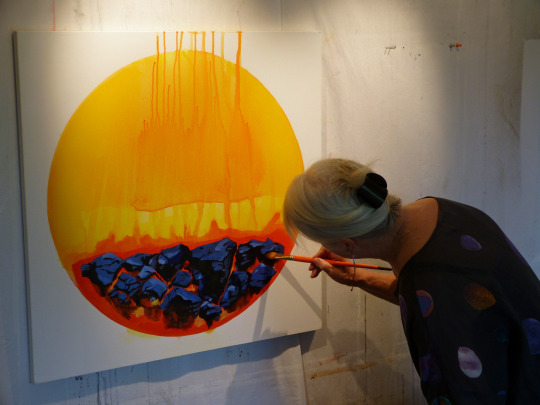
The artist painting “Red and Blue Coals.”
Does collaboration play a role in your work—whether with your community, artists or others?
At this point in time, I do not do collaborative work per se. I hold an annual retreat/workshop at Ghost Ranch in Abiquiu, New Mexico where those who attend influence each other We do not do a collaborative piece, however. I paint with others—sometimes with large groups. The collaboration and selflessness in these situations involves artists helping others. Immersion for the 7 days within the confines of 160 million year-old layers upon layers of colorful sedimentary rock is quite nourishing for the soul.
Considering the political climate, how do you think the temperature is for the arts right now, what/how do you hope it may change or make a difference?
I am thrilled and amazed to read about and see art exhibitions targeting the current block-headed policies of this current administration. My postings on Facebook and on Twitter of my work touching on climate destruction and the dangers of nuclear activity might hopefully awaken some people to what the truth is—what our planet is facing.
Artist Wanda Ewing, who curated and titled the original LFF exhibit, examined the perspective of femininity and race in her work, and spoke positively of feminism, saying “yes, it is still relevant” to have exhibits and forums for women in art; does feminism play a role in your work?
Some of my work could be considered feminist—such as a series of faces of women. However, and perhaps more significantly, my husband and I sponsor an annual Recognizing the Art of Women (RAW) show at the Norton Museum in West Palm Beach, Florida. This show is the first of its kind at the Norton and we feel that the artists shown (such as Jennifer Saville, Njideka Akunyili Crosby, Phyllida Barlow among others) can only serve to highlight the significant work of contemporary women artists.
Ewing’s advice to aspiring artists was “you’ve got to develop the skill of when to listen and when not to;” and “Leave. Gain perspective.” What is your favorite advice you have received or given?
Listen to that quiet voice within that propels one to fearlessly be creative.
https://manhattanarts.com/mary-lou-dauray/
~
Les Femmes Folles is a volunteer organization founded in 2011 with the mission to support and promote women in all forms, styles and levels of art from around the world with the online journal, print annuals, exhibitions and events; originally inspired by artist Wanda Ewing and her curated exhibit by the name Les Femmes Folles (Wild Women). LFF was created and is curated by Sally Deskins. LFF Books is a micro-feminist press that publishes 1-2 books per year by the creators of Les Femmes Folles including the award-winning Intimates & Fools (Laura Madeline Wiseman, 2014), The Hunger of the Cheeky Sisters: Ten Tales (Laura Madeline Wiseman/Lauren Rinaldi, 2015), BARED: contemporary art and writing on bras and breasts (2017, edited by Laura Madeline Wiseman) and Mes Predices (catalog of art/writing by Marie Peter Toltz, 2017). Other titles include Les Femmes Folles: The Women 2011, 2012, 2013, 2014, 2015 and 2016 available on blurb.com, including art, poetry and interview excerpts from women artists. See the latest call for work on the Submissions page!
#mary lou dauray#manhattan arts international#contemporary art#women in art#feminist art#les femmes folles#herstory
0 notes
Text
Hyperallergic: Weighing Ai Weiwei’s Work Amid Butterflies and Botanical Life
Installation view, Ai Weiwei at Meijer Gardens: Natural State (all photos by the author for Hyperallergic)
GRAND RAPIDS, Mich. — I’ve had the recent good fortune to visit a number of art exhibitions in botanical gardens — either installed directly within the conservatories or in adjacent galleries. Much of the wealth of art institutions is directed toward conservation; it creates an interesting parallel to see art objects displayed in places that are typically devoted to the conservancy and maintenance of living creatures. Like many museums, botanical gardens are largely research facilities, while dealing heavily, in their public-facing aspects, with aesthetics and questions of interpretation and audience engagement.
The Fredrick Meijer Gardens & Sculpture Park occupies a site originally slated for a Meijer store — Meijer being a major catchall retail chain (like Target) ubiquitous in most Great Lakes states (and Kentucky). But due to community opposition, it instead became the location of a sculpture garden, a pet project of the chain’s founder, Fredrick Meijer. In addition to a permanent collection of art on the grounds, the institution houses traditional botanical environments — desert/arid and tropical — as well as an art gallery. All of these are currently hosting different aspects of an exclusive exhibition of works by Ai Weiwei, titled Natural State.
Ai Weiwei, “Free Speech Puzzle” (2015), hand-painted porcelain in the Qing dynasty imperial style
Discussion of this exhibition began years ago, sparked by Meijer Gardens’ acquisition of Ai’s “Iron Tree,” which is now a permanent part of the sprawling sculpture garden that surrounds the indoor facilities. Joseph Becherer, chief curator and vice president of horticulture and sculpture collections and exhibitions, worked intensively with Ai — who was, at that time, still under house arrest in China — to purchase and install the work according to his specifications. The diligence demonstrated by Meijer Gardens during the installation of “Iron Tree” impressed upon the artist the institution’s capacity to execute a larger-scale exhibition. Becherer and Ai seem to have struck up a friendship over the years.
Ai Weiwei’s “Iron Tree,” part of the permanent collection at Meijer Gardens
The works in the exhibition appear in three zones: the traditional galleries, the interstitial space between galleries and conservatories, and the conservatory environments themselves. Much of the work on display is porcelain, although the non-conservatory areas also feature wallpaper installations, which give the large galleries a sense of fullness, even with a rather spare distribution of sculptures. Lofted above the main causeway connecting the conservatories to the lobby are a selection of Ai’s bamboo and silk kites (previously shown in a department store in Paris). The main gallery displays Ai’s rendering in Legos of the controversial photographs that document his destruction of a Han dynasty urn. All the rest of the works on display are porcelain or ceramic.
Within the conservatories, the pieces struggles to hold their own. A number fight for attention with the botanical installations — for example, the large, blue, ceramic water drop sculptures in the desert room could be taken for little more than garden art. This is particularly true of the tropical room’s giant pots and “tofu” ceramic sculptures (which resemble large blocks of tofu, but are also a play on words criticizing the shoddy construction practices that resulted in fatalities during the Sichuan earthquake); due to their scale and pastel shades, they almost give the appearance of being Disneyland props. The sense of fancifulness is enhanced by the seasonal, live butterfly zone, in which some 7,000 exotic butterflies have been set loose. It is the rare artwork that can compete with a kaleidoscope of Blue Morphos. In another botanical wing, I witnessed a family group cheerfully posing for a portrait with the colorful porcelain twists that mimic the rebar commemorating the children who died in the 2008 Sichuan earthquake.
Installation view, Ai Weiwei at Meijer Gardens: Natural State
Ai Weiwei, “Porcelain Rebar” (2015)
The work outside the conservatories better retains its identity as art — but even in the lobby, people pose for selfies in front of the wallpaper showcasing the flower displays that came to symbolize Ai’s incarceration at the hands of the Chinese government. Here, at least, one detects the artist’s wry humor: with his keen understanding of the digital culture that promulgates his messages, Ai has hung a blow-up of his own selfie, taken moments before his arrest and detention without trial, in the center of a colorful wall that will become the backdrop for a host of unironic visitor selfies. In the main gallery, a series of Han dynasty pots have been refinished in shiny automotive paints — a nod to the local flavor.
In the lobby gallery: Ai Weiwei, “With Flowers” (2013–15), wallpaper, and “Illumination” (2009) color print on dibond
Unlike other botanical gardens I’ve visited, which were mainly patronized by a few moms with strollers, Meijer Gardens is bustling with activity. Grand Rapids schoolchildren routinely visit, with special curriculum related to the botanical components, physical education activities tied to the sculpture garden, and, of course, walks through the art galleries. This represents a wide audience, one perhaps unaware of or unreachable through more conventional fine art settings, and thus there’s an opportunity for exposure to some of Ai’s more politically pointed messaging.
Yet, in wandering the galleries and grounds, I found myself searching for comparisons and grasping for a conclusion. Is it good to provide broader access to the work of Ai Weiwei, regardless of whether or not the context blunts the politics? Or does art, stripped to any degree of its social commentary, becomes instantly objectified and purposeless? Can really great art communicate its intention, regardless of context and the potential indifference or intractability of an audience?
Ai Weiwei, detail of “He Xie” (2011), porcelain
“I still see and feel the strong political and personal commentary in much of the work,” said Becherer in an email interview that followed a tour of the show. “It seems very present to me, although the context does not project boldly as it did at Alcatraz, for example. Here at Meijer Gardens, the messaging may be a little more subtle and contemplative, but it has another strength: when I consider ‘Blossom’ or the flower wallpaper, or even the vitrines of smaller scale ceramic work, it is normal to want to linger in notions of the botanical, but there is a strong counterpunch in looking at the bold cultural and political statements those kinds of works really make. Having said that, there is something in the quiet beauty and fragility that the works … offer that resonates here. You see the power and transience of the natural world, another kind of protest. On the flip side, the two things Weiwei most deeply cares about, human rights and freedom of speech, are beautiful and fragile, like so many aspects of the ‘cultivated’ natural world. Left unattended, or worse, uncared for, that fragile beauty can be choked, can die and can disappear.”
Ai Weiwei, “Remains” (2015), porcelain
Advertising, as retailers well know, works through exposure: It doesn’t matter how smart you are; if you hear the same jingle enough times, it will get stuck in your head. By creating exposure to lovely objects imbued with meaning, are we planting seeds for critical thinking about society — or are we just creating a backdrop for ever more selfies? Can a message about free speech be clearly conveyed to an American audience, even when it is written in Chinese — both literally, as Ai’s work tends to be, and metaphorically, as it emerges from a context in which free speech is neither a right nor a given? It is possible that the extreme measures taken by governments to suppress artistic expression are reflective of an understanding that art has the power to shake society at its foundation. And of course, those who benefit most from the existing hierarchy have no real reason to support ideas that are disruptive to it. In the US, philanthropy tends to be characterized as beneficial to art, but there’s always the sinister possibility that anything introduced into a capitalist system becomes little more than a commodity.
On balance, I would rather have a botanical garden than a Meijer convenience store, but this environmental and aesthetic monument is, of course, built by the wealth of commerce and, in many ways, a demonstration of it. Arts philanthropy is popular among wealthy people as a means of reinforcing their image as generous and genteel — and as a convenient tax shelter, a way of using upper-class, otherwise taxable dollars to purchase expensive art and have it displayed in a building or wing bearing their name. Nonetheless, in a country where public funding for the arts is under threat, I cannot argue against the merits of redirecting monies that would end up funding international displays of aggression by small men into a wonderland of butterflies. And though I can speculate about the ways it might change the physical and cultural landscape to transform every Meijer into a sculpture garden or tropical adventure zone, sooner or later I, too, need to buy groceries, and perhaps a bookshelf, and get a prescription filled — and my local Meijer is a convenient place to do so. Perhaps providing an environment hospitable to such musings is the best we can expect from the rare benefactors of capitalism, in this day and age.
Ai Weiwei, “Taifeng” (2015), bamboo and silk
Ai Weiwei, “Water Drop” (2008) and “Cone” (2007)
One of Ai Weiwei’s large pots installed in the Lena Meijer Tropical Conservatory
Ai Weiwei, “Finger” (2014), wallpaper, and “Oil Spills” (2006), porcelain
In the main gallery: Ai Weiwei, “The Animal that Looks Like a Llama but is Really an Alpaca” (2015), wallpaper; “Dropping a Han Dynasty Urn” (2016), LEGO bricks; “Han Dynasty Vases with Auto Paint” (2015), Han dynasty vases (202 BCE–220 CE) and auto paint
Ai Weiwei at Meijer Gardens: Natural State continues at Fredrick Meijer Gardens & Sculpture Park (1000 East Beltline Ave NE, Grand Rapids, Michigan) through August 20.
Editor’s note: The author’s travel expenses were paid for by Meijer Gardens.
The post Weighing Ai Weiwei’s Work Amid Butterflies and Botanical Life appeared first on Hyperallergic.
from Hyperallergic http://ift.tt/2r7dMDS via IFTTT
0 notes
Text
New York, NY

I wasn’t really sure of my wife’s motivation for visiting New York City. Perhaps it was the fashion of the city, or maybe it was just that she loved the show Sex and the City, which I admit I enjoyed watching with her. I wasn’t against going, but it was never one of my top five destinations, especially in the winter. The stories I’d heard about rude New Yorkers was the main reason I was hesitant to go. She ended up going there without me and had a blast with one of her friends. Such a good time, in fact, that she went back several more times. But she really wanted me to go there with her, so I agreed and we booked our trip there to arrive just after New Years.
We arrived to Mitchell Airport in Milwaukee intentionally late because we saw that our flight was delayed before we left the house. I suggested we stop at Chili’s Too for a few drinks. I finished my 2nd Leinenkugel’s Bavarian Dunkel and we started heading for our gate just as we were being paged. They decided to bump up the delay 30 minutes and we were the last to board the flight.
We made it to our hotel where I sat and had a few beers at the bar. Sam Adams Winter Ale & Goose Island IPA were their only decent selections. We wandered around a bit, killing time before dinner, and found an upscale bar called “The Vine.” It looked like a lot of younger businessmen & women were enjoying the happy hour there as we were lucky to get a table. I tried a few local brews while the very attentive staff kept our water glasses full as well as a cup of parmesan-topped cheese balls.
Looking at the map, the wife discovered a taproom about a mile away with a good menu. We made our way in the drizzle to Taproom No.307, which had an amazing beer selection. They were having a trivia contest when we arrived, but once again we were lucky enough to get the last open table. I tried a great variety of beers all brewed in the New England/New York/Pennsylvania area. My favorites were Mad Elf by Tröegs, Peach Short Weisse by Smuttynose, and McKenzie’s Hard Cider Seasonal Reserve. The staff here was also very attentive, especially considering the place was packed on a weeknight. The wife had a sad look on her face when I finished off the last of our shared bucket of tater tots, which caught the attention of a manager. He came right over and asked what was wrong, and she just laughed and said, “it’s ok...my husband just ate all of the tots.” He went back to the kitchen and immediately brought us another bucket, on the house.

We spent the next day wandering around the far southern end of Manhattan. I wanted to see Battery Park and the 9/11 Memorial. We also saw a piece of the Berlin Wall (very close to the World Trade Center), Wall Street (we flipped off the Trump Building), and the famous Charging Bull statue. That night we went to the Empire State Building. There was a long line to go up to the observation level, so we skipped that and cut through the line to visit Heartland Brewery on the ground floor of the skyscraper. The doorman yelled at me as we passed through, “you’re going down on Sunday! You’re going DOWN,” obviously referring to my Packers coat and that the Packers were playing against the Giants in a playoff game that coming weekend. Not a lot of the beers impressed me here, but I did enjoy their pumpkin ale as well as their Old Red Nose Ale.


On Thursday we went to Central Park. I was thrilled to see Dana Barrett’s apartment building from Ghostbusters. We walked through a little less than half the park, which is a little surreal being in a huge park surrounded by skyscrapers. I imagine New Yorkers feel the opposite, where it’s surreal to have a large park with lakes and trees in the middle of the city. We then went to the American Museum of Natural History, made famous on TV by Neil deGrasse Tyson. We paid extra to see a planetarium show about dark matter. But as the day went on the children in the museum became more and more unruly which exhausted both of us, so I found a nearby restaurant called Amsterdam Ale House. Here I tried a handful of Pennsylvania beers (my favorite being the Troegenator Doublebock), a couple New York beers (is everything by Sixpoint hoppy?), and a very good Belgian import called N’Ice Chouffe.


Friday we visited the birthplace of Teddy Roosevelt and were given a tour of his family home. Then we decided to leave Manhattan and check out Brooklyn. I found an area with four breweries within walking distance of each other, so we started at Threes Brewing. We arrived before 5:00, so the crowd hadn’t shown up yet. I sampled a number of their beers, but skipped most of their IPAs which seemed to be half of their menu. I really liked their cracked wheat Table Beer and Universal Mirror black saison. One of their guest beers was a black gose aged in red wine barrels called The Sun Is Too Bright by Finback Brewery in Queens, and it was excellent.

The crowd started pouring in after 5:00 so we moved on to Strong Rope Brewery just a few blocks away. I was very unimpressed with most of their beers, as they had an unpleasant woody taste to them. I did enjoy their Squash Maple Brown and their Galactic Travel Constant stout.

We were both starting to get hungry and we realized the next brewery didn’t have a food menu, so we abandoned my planned brewery crawl and called a Lyft driver. Two of my goals for the day were to visit Brooklyn Brewery and eat authentic New York pizza. Unfortunately Brooklyn Brewery was far out of the way and we just wanted to eat, so I looked up Jon Stewart’s list of recommended New York City pizza places and found Grimaldi’s located just under the Brooklyn Bridge. It was amazing pizza, despite the fact that almost nothing else was on the menu; no appetizers, no alcohol, and they did not take credit cards.

The wife, whom’s mood was elevated by the good pizza and perhaps being able to take in the sight of being under the Brooklyn Bridge for the first time, decided to take me to a place she found in Midtown called Beer Authority. I was very pleased to be able to watch the NJ Devils game there, until I saw they were down 4-0. I tried a Belgian beer, a NY beer, and a wheat peach ale from South Carolina called Son of a Peach.

I’d said I’d like to see Times Square on New Years “just once” as they always tell you on the NYE shows. But prices and crowds are significantly down after New Years, so that was when we decided to book our trip. We never did make it to Times Square, but walking home from the Beer Authority we were only blocks away, almost able to make out some of the large, lit-up billboards.
The next day we were having lunch at the hotel and saw on the TV that the light dusting of snow we were supposed to get turned into a winter storm warning. It took a long time for our Lyft driver to pick us up and the drive to the airport took twice as long as it should have due to people not knowing how to drive in 2” of snow there. Many of the flights were cancelled due to the weather, making the check-in line 45 minutes long. By the time we got to the counter to check in our luggage, we’d missed our flight. We rebooked a flight for Sunday night and went back to Brooklyn. I decided if we were going to be stuck there another night, I’ll check Brooklyn Brewery off my to-do list...so we booked a hotel a block away.

I went to the brewery by myself as the wife needed to make a quick trip to Walgreens for additional provisions for the unplanned extra night. I got there at about 5:00 and it was an absolute madhouse. You are to buy beer tokens when you walk in for $5 each or $20 for 5. Most beers are 1 token, while some others are two or three. I had to wait in a very long line for the beer; probably 10-15 minutes. The taproom was standing-room only as it was completely packed and it was very loud. I finally got up to the bar and I was allowed to order no more than 3 beers. I chose the Black Chocolate Stout (probably my favorite beer of the entire trip), Insulated Lager (dark and excellent), and the Brown Ale (also great). With my final chip (the Black Chocolate Stout cost me 2) I decided on the belgian dubbel Cassock, which was also excellent. I definitely would have stayed longer and had more beers if the place wasn’t so busy, but it was a Saturday night during a winter storm.
The next day we had plenty of time to kill before going back to the airport so we found another nearby brewery open for brunch. We trudged through 7 blocks of snow-covered sidewalks and chilly wind gusts off the harbor to Greenpoint Beer and Ale Company. I had a flight, but only one beer impressed me: Milk And Honey blonde ale. I was assured their Murk double IPA was award-winning, but I really didn’t like it much at all. There we watched the early NFL playoff game, Miami vs Pittsburgh, and there were a good number of Steelers fans in the bar.
We decided to make our way to the airport early so I would be able to watch the Packers and Giants playoff game. We curb-checked our luggage to avoid the long line and made it through security just in time for kickoff. The bar had Brooklyn Brewery’s IPA and lager on tap so I took advantage of those throughout the game. During the first half the bar was packed with mostly Giants fans, but they all quietly cleared out after the Aaron Rodgers hail mary at halftime. In the 2nd half, more and more Packers fans on our flight to Milwaukee filed in and celebrated the win.
My first trip to New York City was a lot of fun. The city is a little overwhelming, as there seems to be something to do every block. The people are surprisingly friendly. I recently re-watched Ghostbusters 2 and they kept repeating that New Yorkers are miserable and don’t care about anyone else, but I found it to be quite the opposite. Service in most restaurants and bars is very good, likely because there is so much competition they want to do whatever they can to keep a customer from going next door. I am looking forward to our next trip there, when I’m sure the weather will be better.

0 notes